While the United Arab Emirates was formed in 1971, the earliest records of education systems can be traced to the beginning of the 20th century. Before the advent of the Modern Educational System, the Ministry of Education surmises that there were three iterations in educational development, including the Mutawa and the Katateeb, Educational Circles and Semi-Organized Education.
Sheikh Saqr Bin Sultan Al Qasimi, since his accession in 1951 as the Ruler of Sharjah, was a pioneer in encouraging modern education in the Trucial States and spent a good proportion of his revenues on its expansion. He encouraged the development of the state school Al Qasimiyah, which was opened in 1953 with the British providing a new building and adopting the Kuwaiti curriculum. The following year, the first school for girls started in Sharjah, called Fatima A’zahra’a.
A Five-year Development Plan was conceived, and covered a wide field including water development, agriculture, education, public health, police services, and public works. The success of the plan made it possible to go ahead with an accelerated program, which included a Trade School at Sharjah, an Agricultural School at Ras al Khaimah, the provision of teacher training for Trucial States students at Bahrain and the construction of four elementary schools. In 1959, Sheikh Zayed Bin Sultan Al Nahyan, then Ruler’s Representative in the Eastern Region, set up Al Nahyaniah primary school in Al Ain. In 1959, Qatar Education Department started providing teachers and constructed schools in Dubai and Sharjah.
After Abu Dhabi began to generate large oil revenues in the 1960s, it developed and funded its own educational system.
On December 2, 1971, the UAE celebrated not only the formation of its Government but a new schooling system. One of the first government bodies set up was the Ministry of Education and Youth, which was headed by the then Ruler of Sharjah, Sheikh Sultan bin Mohammad Al Qasimi. The second phase of modern systematic education focused on building public schools, with the primary focus to increase literacy.
More recently, one of the biggest educational developments the nation has undergone is the experimental New School Model in Abu Dhabi. This revolutionary curriculum was inaugurated in 2008, with two teachers in each class - one English and one Arabic - for a bilingual learning model.
It has now become the most advanced Arab country in international education, as evidenced by the results of a study on Trends in International Mathematics and Science Study (TIMSS) that shows UAE’s superiority in science, mathematics and languages.
Author: UAE National Library and Archives

Narrative regarding the Agricultural School at Ras Al Khaimah, from a report on the visit to the Trucial States and Bahrain by J.C. Eyre, Agricultural Adviser, Middle East Development Division, 10-19 March 1957. © Images reproduced by permission of The National Archives, London, England

Establishment of a school at Al Muwaiji by Sheikh Zayed Bin Sultan Al Nahyan, extracted from report of Martin Buckmaster, Political Officer, Abu Dhabi, 16 May 1957. © Images reproduced by permission of The National Archives, London, England

Extract from a report on the visit to the Trucial States submitted by Sayyed Abdul Gadir Okair, Assistant Director in the Ministry of Education, Sudan, 30 April 1960. © Images reproduced by permission of The National Archives, London, England

Extract from a report on the progress of the Trade School at Sharjah, prepared by John H. Taylor, Headmaster, Sharjah Trade School, July 1960. © Images reproduced by permission of The National Archives, London, England
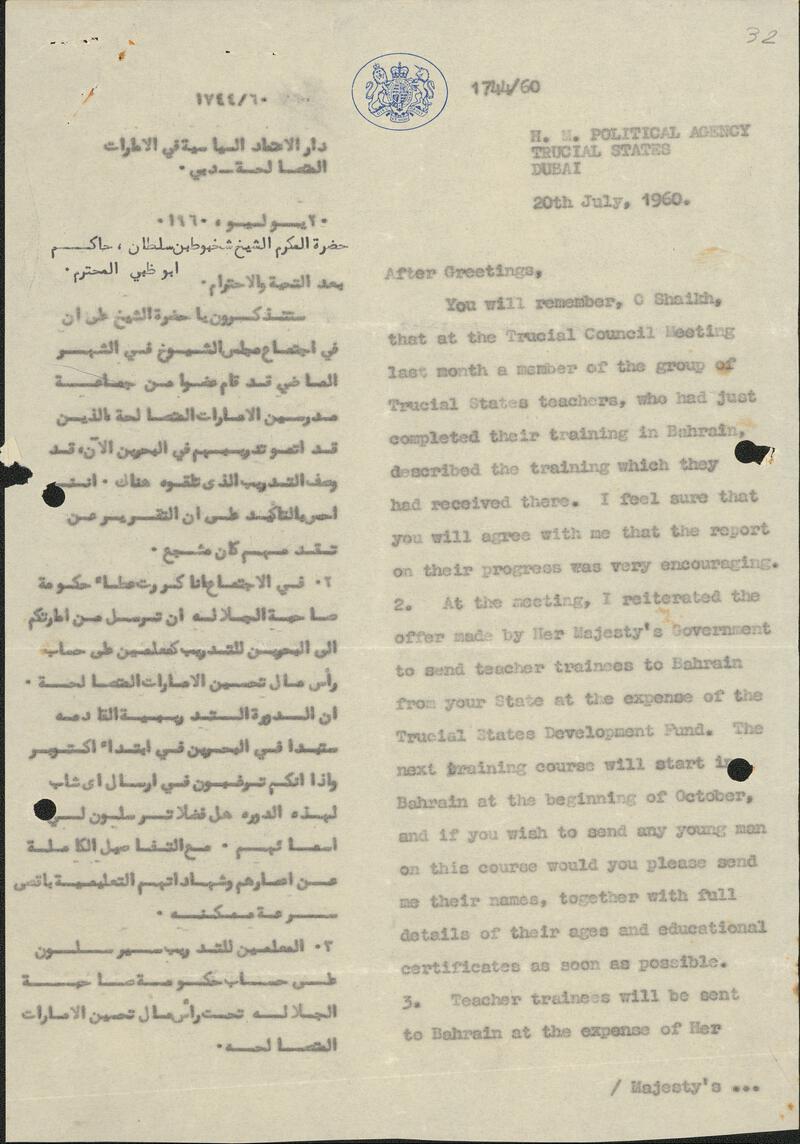
Letter from D. F. Hawley, British Political Officer, to Sheikh Shakhbut Bin Sultan Al Nahyan, Ruler of Abu Dhabi, regarding teachers’ training in Bahrain, 20 July 1960. Source: UAE National Library and Archives

Letter from D. F. Hawley, British Political Officer, to Sheikh Shakhbut Bin Sultan Al Nahyan, Ruler of Abu Dhabi, regarding teachers’ training in Bahrain, 20 July 1960. Source: UAE National Library and Archives

Letter from I.S. Winchester, Political Agency Dubai to J.A. Ford, British Residency, Bahrain regarding the proposed appointment of a Sudanese Director of Education for Dubai, 19 October 1960. © Images reproduced by permission of The National Archives, London, England

Letter from I.S. Winchester, Political Agency Dubai to J.A. Ford, British Residency, Bahrain regarding the proposed appointment of a Sudanese Director of Education for Dubai, 19 October 1960. © Images reproduced by permission of The National Archives, London, England

Letter from I.S. Winchester, Political Agency Dubai to J.A. Ford, British Residency, Bahrain regarding the proposed appointment of a Sudanese Director of Education for Dubai, 19 October 1960. © Images reproduced by permission of The National Archives, London, England
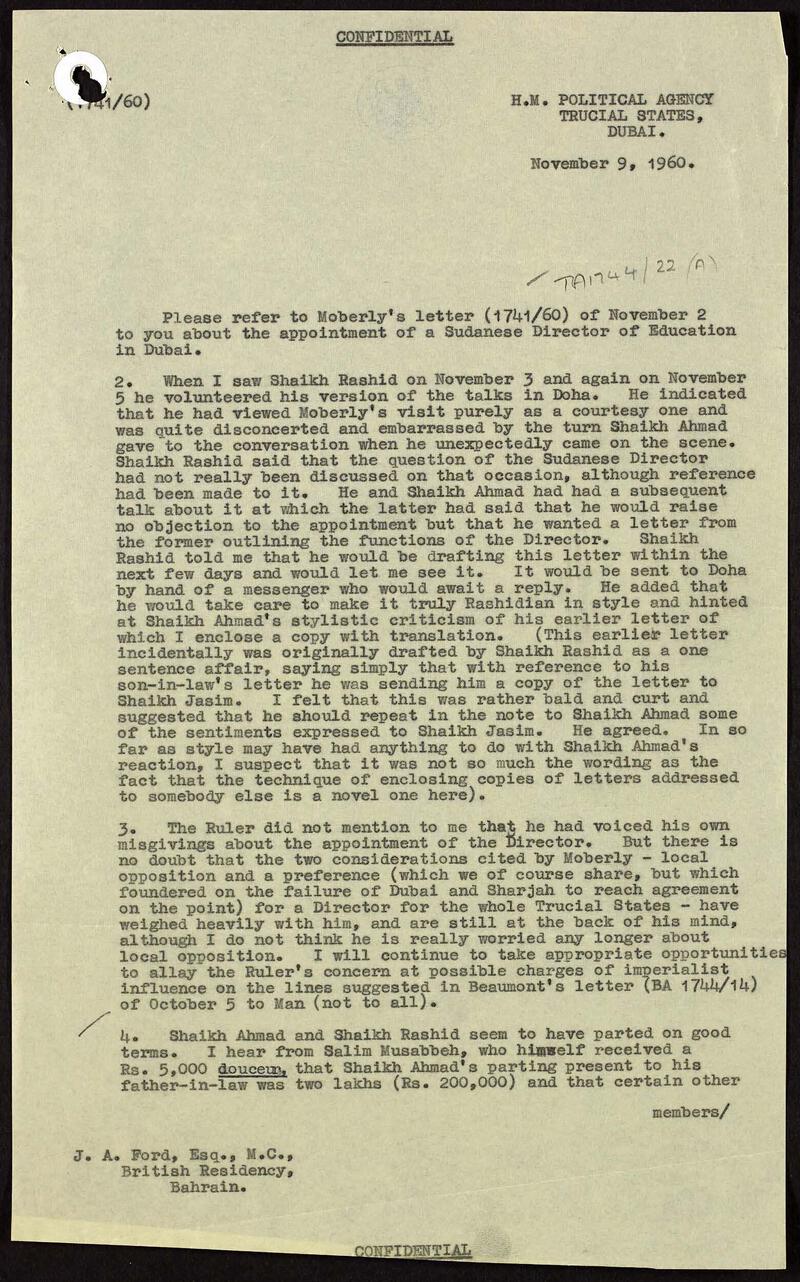
Letter from I.S. Winchester, Political Agency Dubai to J.A. Ford, British Residency, Bahrain regarding the proposed appointment of a Sudanese Director of Education for Dubai, 19 October 1960. © Images reproduced by permission of The National Archives, London, England

Letter from I.S. Winchester, Political Agency Dubai to J.A. Ford, British Residency, Bahrain regarding the proposed appointment of a Sudanese Director of Education for Dubai, 19 October 1960. © Images reproduced by permission of The National Archives, London, England
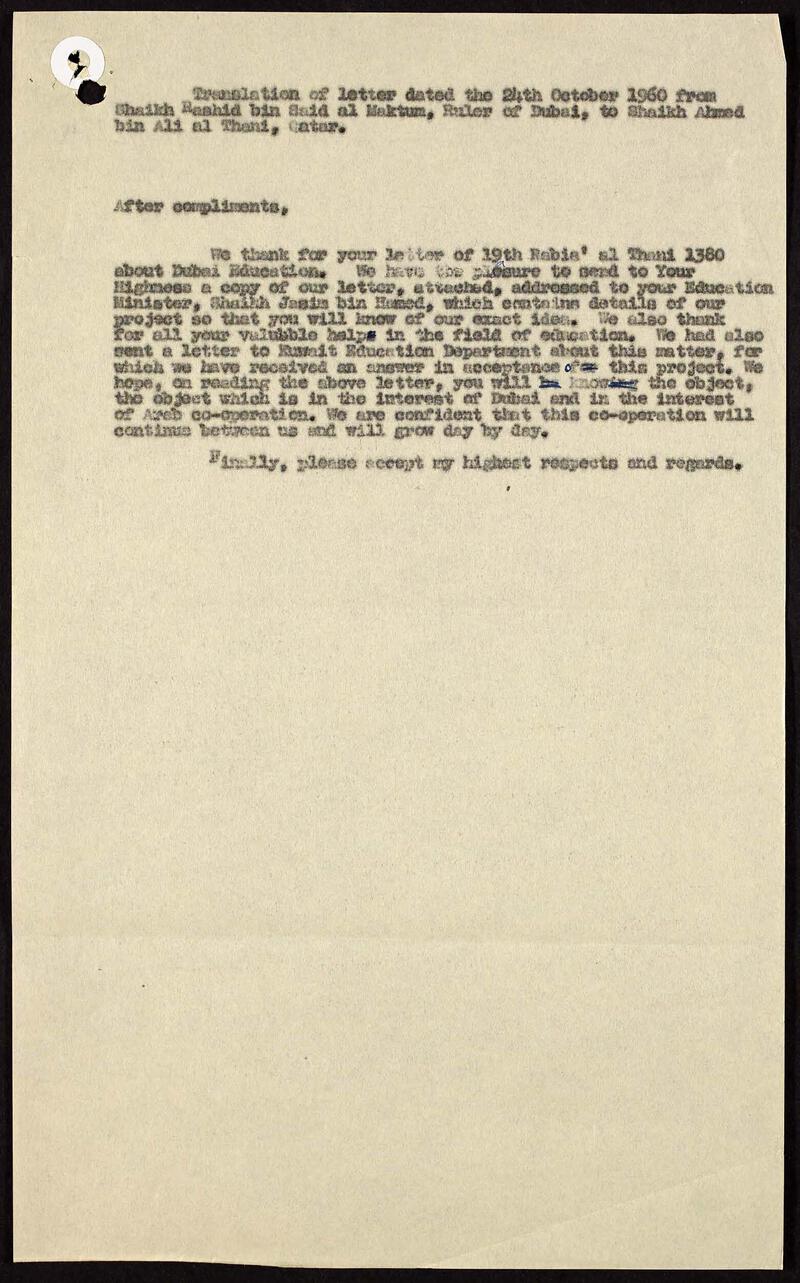
Letter from I.S. Winchester, Political Agency Dubai to J.A. Ford, British Residency, Bahrain regarding the proposed appointment of a Sudanese Director of Education for Dubai, 19 October 1960. © Images reproduced by permission of The National Archives, London, England
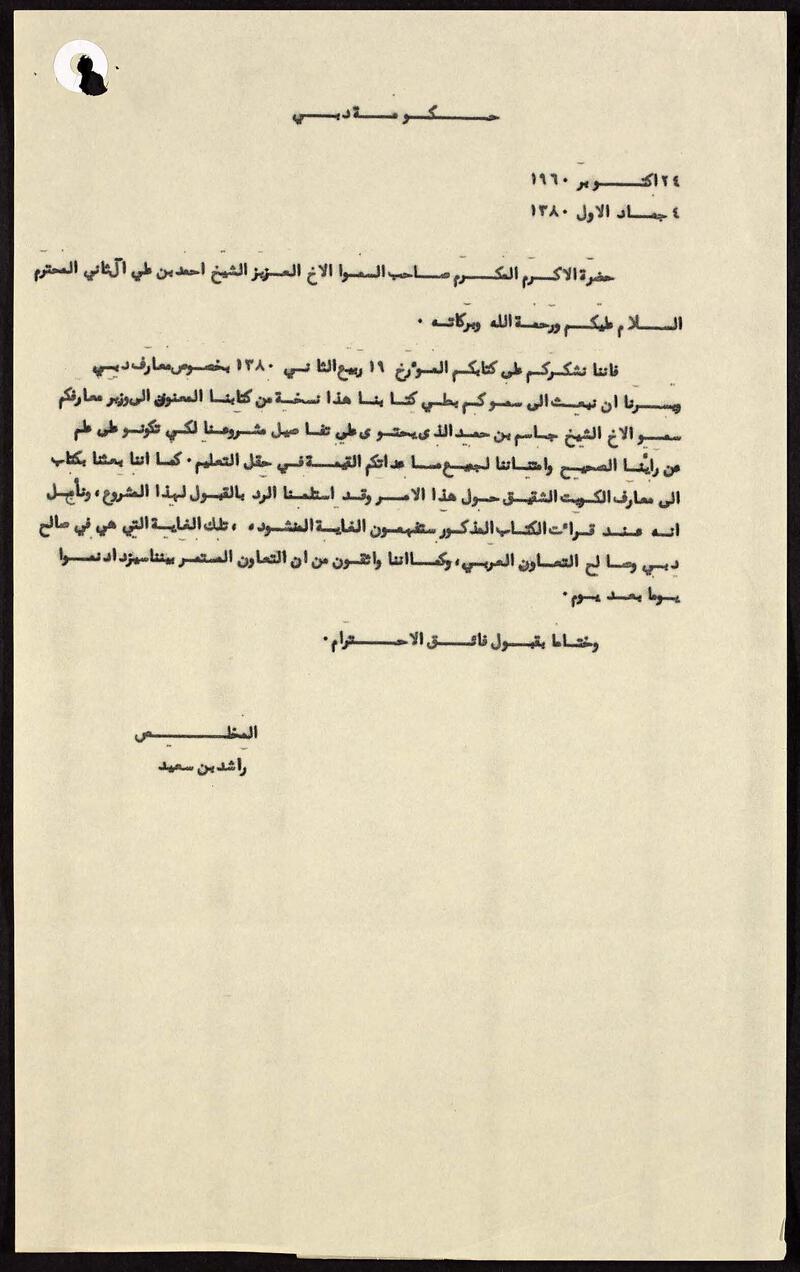
Letter from I.S. Winchester, Political Agency Dubai to J.A. Ford, British Residency, Bahrain regarding the proposed appointment of a Sudanese Director of Education for Dubai, 19 October 1960. © Images reproduced by permission of The National Archives, London, England

Letter from I.S. Winchester, Political Agency Dubai to J.A. Ford, British Residency, Bahrain regarding the proposed appointment of a Sudanese Director of Education for Dubai, 19 October 1960. © Images reproduced by permission of The National Archives, London, England
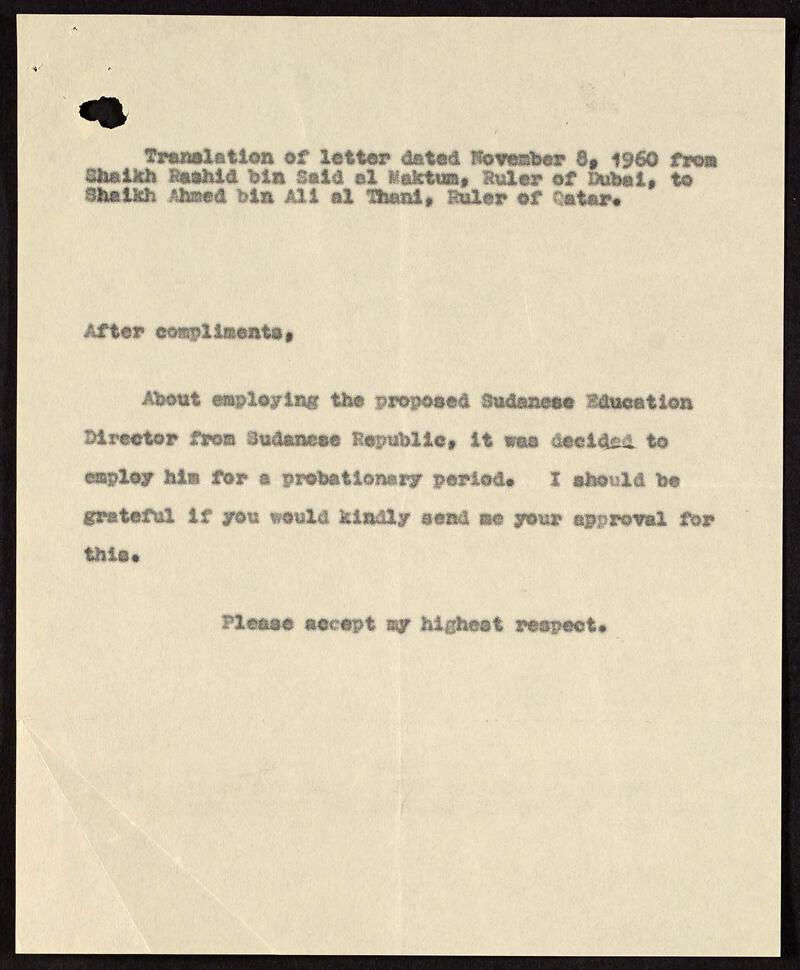
Letter from I.S. Winchester, Political Agency Dubai to J.A. Ford, British Residency, Bahrain regarding the proposed appointment of a Sudanese Director of Education for Dubai, 19 October 1960. © Images reproduced by permission of The National Archives, London, England
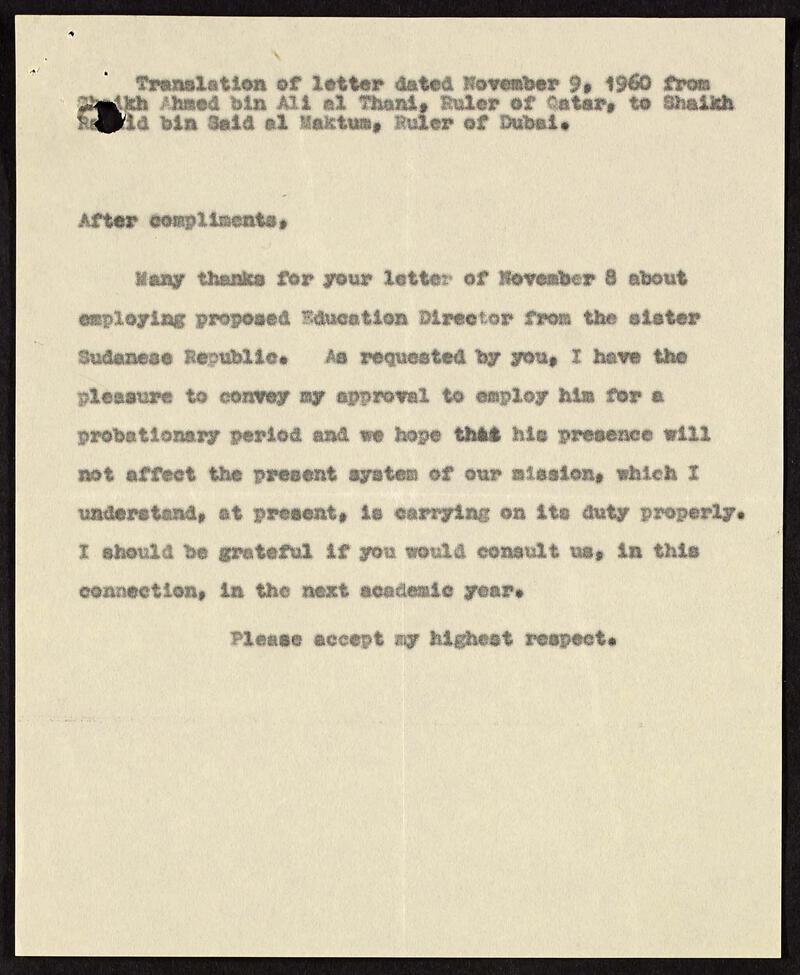
Letter from I.S. Winchester, Political Agency Dubai to J.A. Ford, British Residency, Bahrain regarding the proposed appointment of a Sudanese Director of Education for Dubai, 19 October 1960. © Images reproduced by permission of The National Archives, London, England
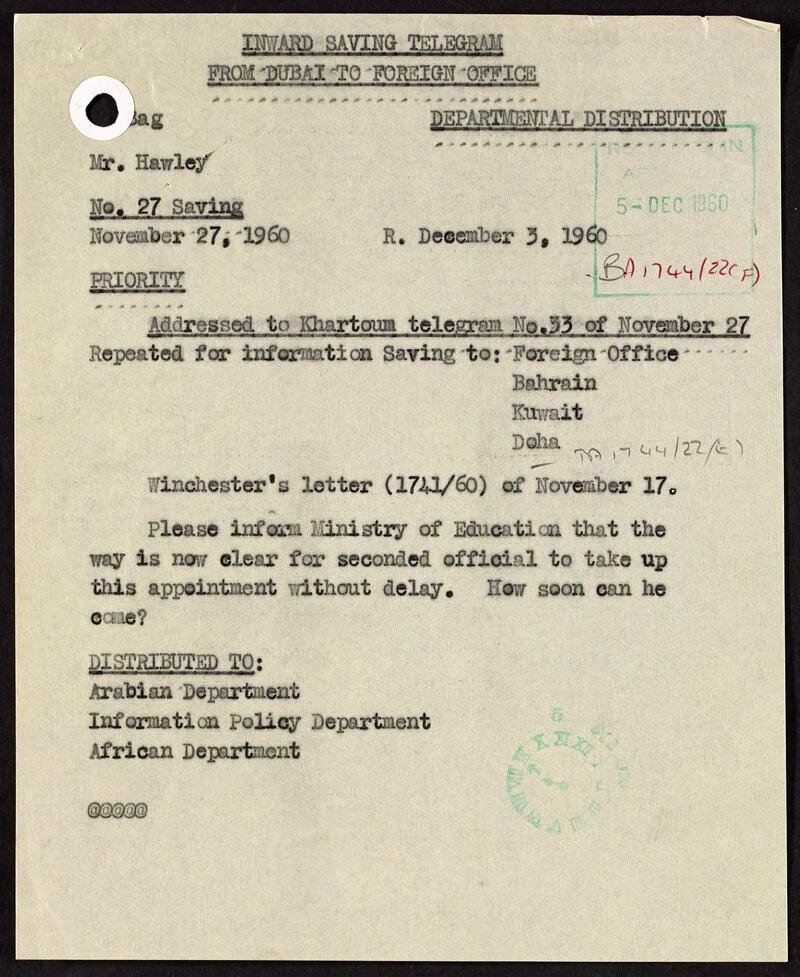
Letter from I.S. Winchester, Political Agency Dubai to J.A. Ford, British Residency, Bahrain regarding the proposed appointment of a Sudanese Director of Education for Dubai, 19 October 1960. © Images reproduced by permission of The National Archives, London, England
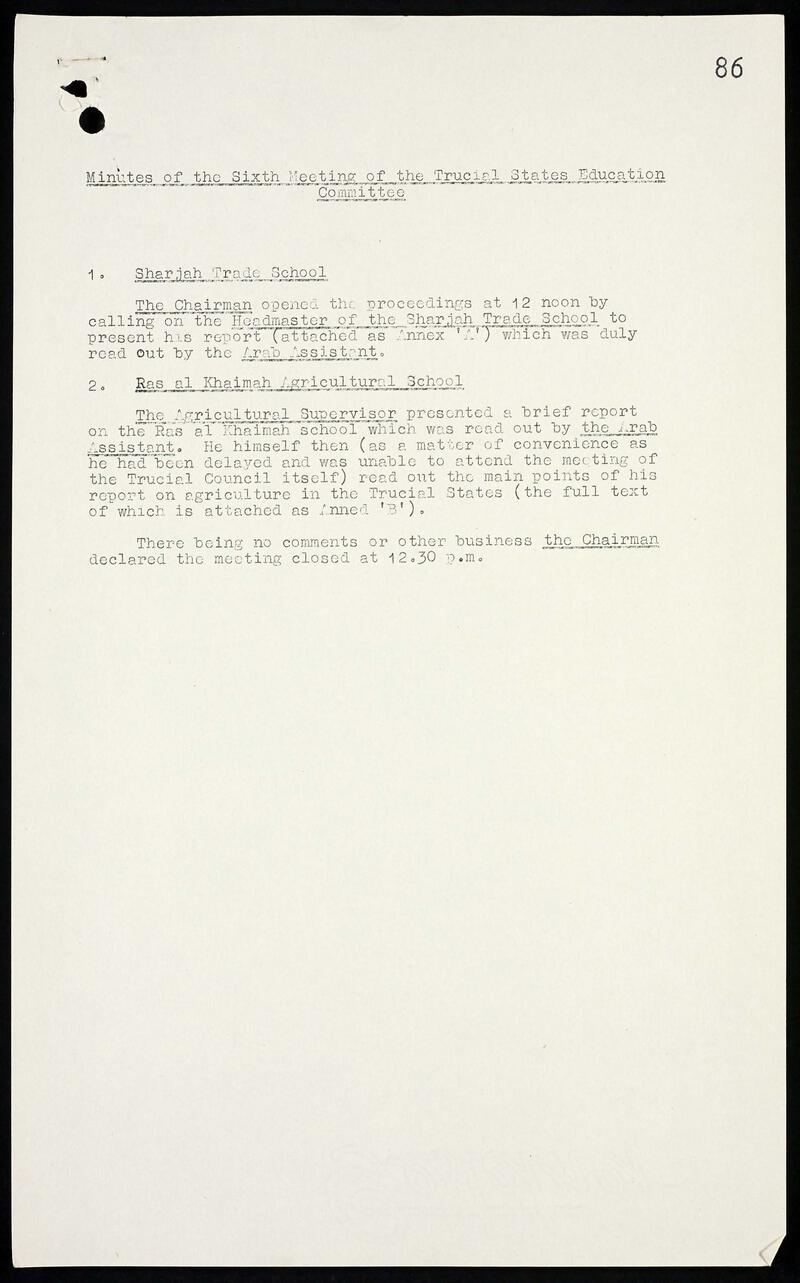
Minutes of the sixth meeting of the Trucial States Education Committee along with Headmaster's Report on the Sharjah Trade School, April 1961. © Images reproduced by permission of The National Archives, London, England

Minutes of the sixth meeting of the Trucial States Education Committee along with Headmaster's Report on the Sharjah Trade School, April 1961. © Images reproduced by permission of The National Archives, London, England

Minutes of the sixth meeting of the Trucial States Education Committee along with Headmaster's Report on the Sharjah Trade School, April 1961. © Images reproduced by permission of The National Archives, London, England

Minutes of the sixth meeting of the Trucial States Education Committee along with Headmaster's Report on the Sharjah Trade School, April 1961. © Images reproduced by permission of The National Archives, London, England

Minutes of the sixth meeting of the Trucial States Education Committee along with Headmaster's Report on the Sharjah Trade School, April 1961. © Images reproduced by permission of The National Archives, London, England
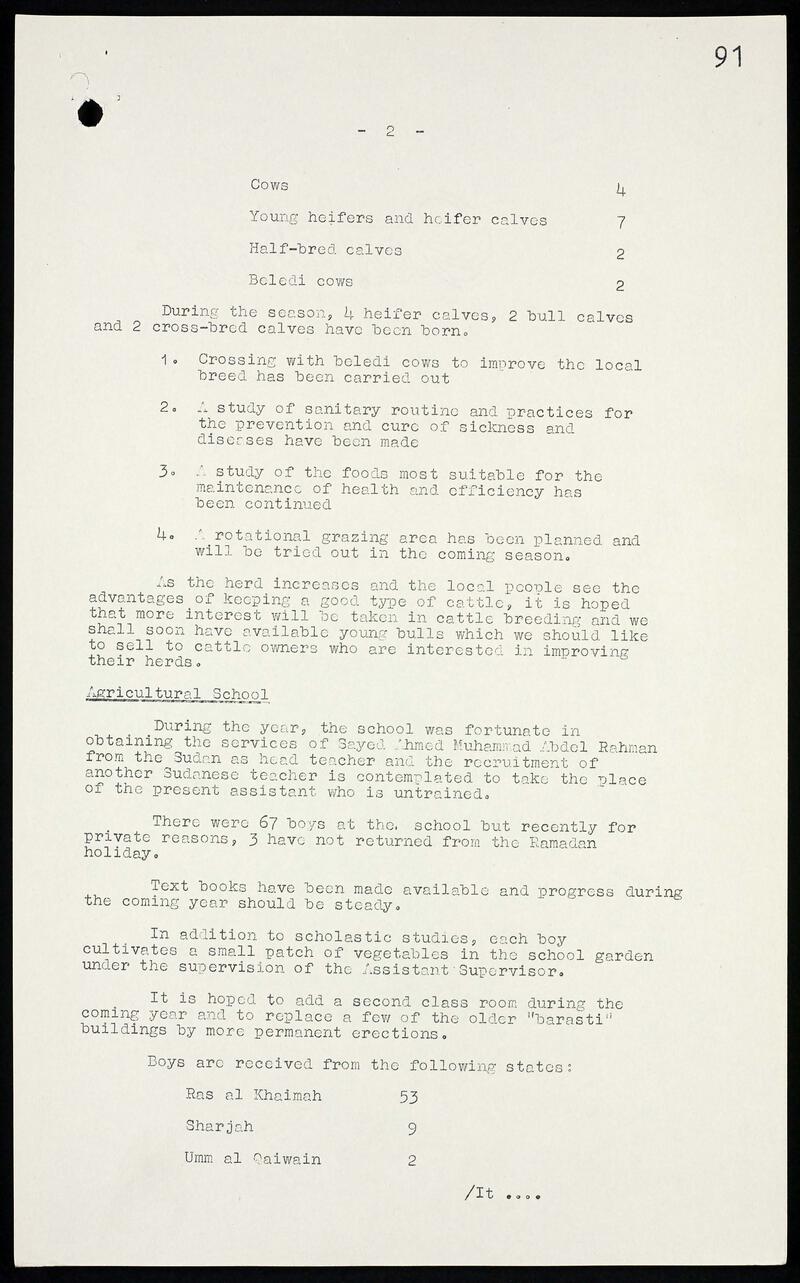
Minutes of the sixth meeting of the Trucial States Education Committee along with Headmaster's Report on the Sharjah Trade School, April 1961. © Images reproduced by permission of The National Archives, London, England
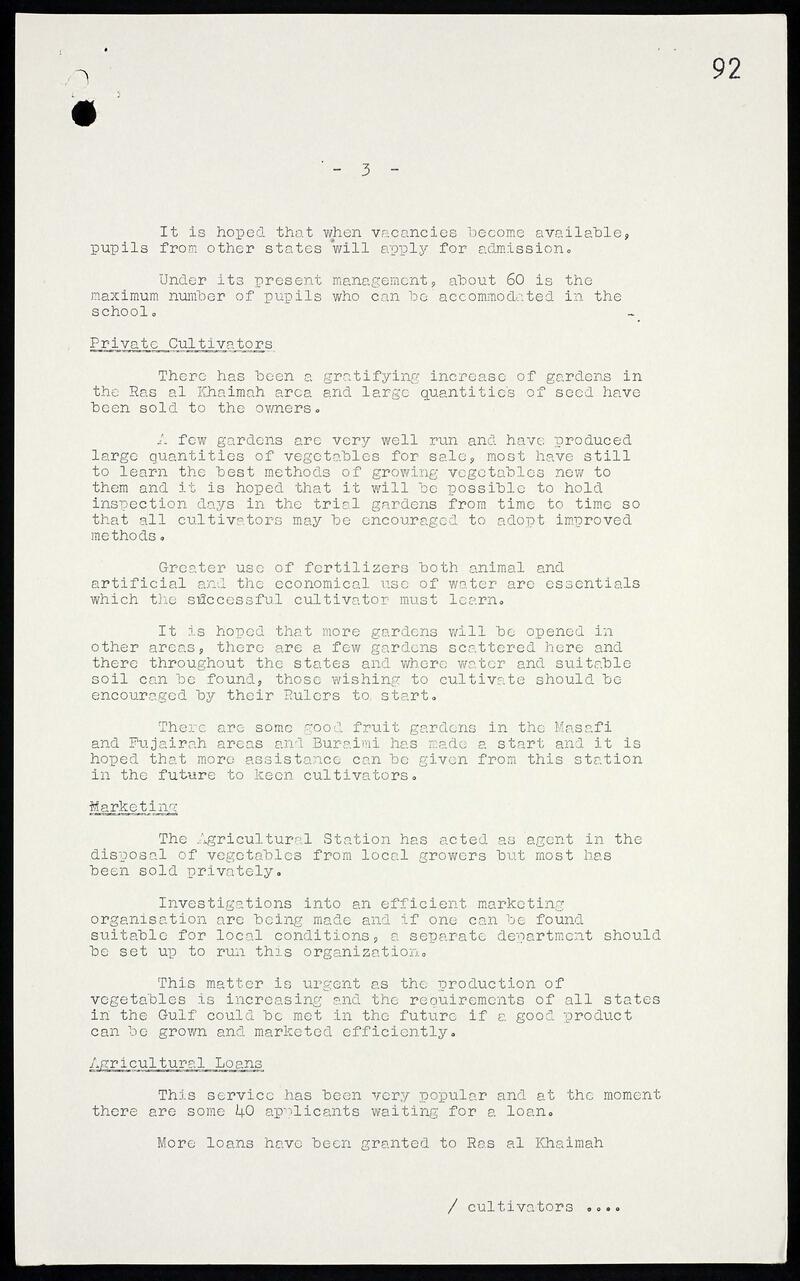
Minutes of the sixth meeting of the Trucial States Education Committee along with Headmaster's Report on the Sharjah Trade School, April 1961. © Images reproduced by permission of The National Archives, London, England

Minutes of the sixth meeting of the Trucial States Education Committee along with Headmaster's Report on the Sharjah Trade School, April 1961. © Images reproduced by permission of The National Archives, London, England

Letter from D.G. Crawford, Foreign Office to M.S. Buckley, Treasury about provision for the building and furnishing of a school at Khor Fakkan in the northeast of the Trucial States, 15 March 1963. © Images reproduced by permission of The National Archives, London, England
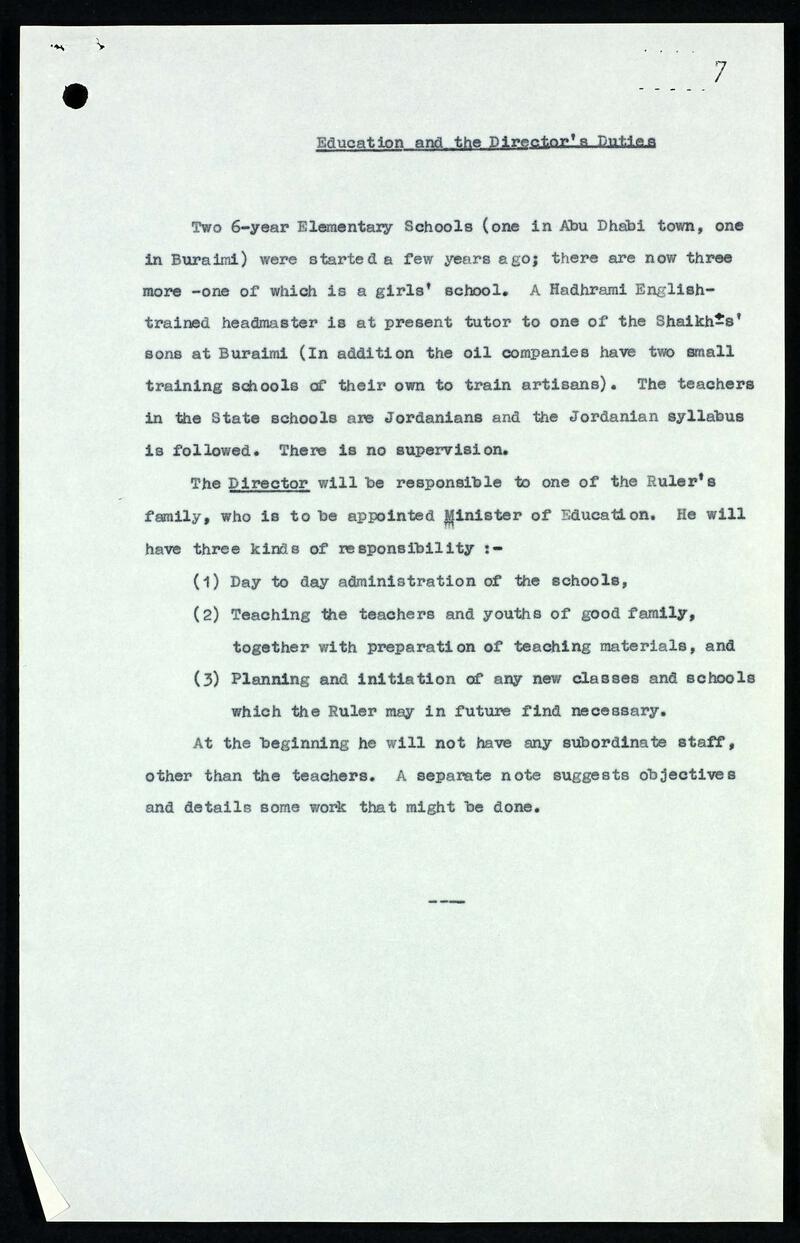
Note on education in Abu Dhabi and the duties of the Director of Education, 6 February 1964. © Images reproduced by permission of The National Archives, London, England
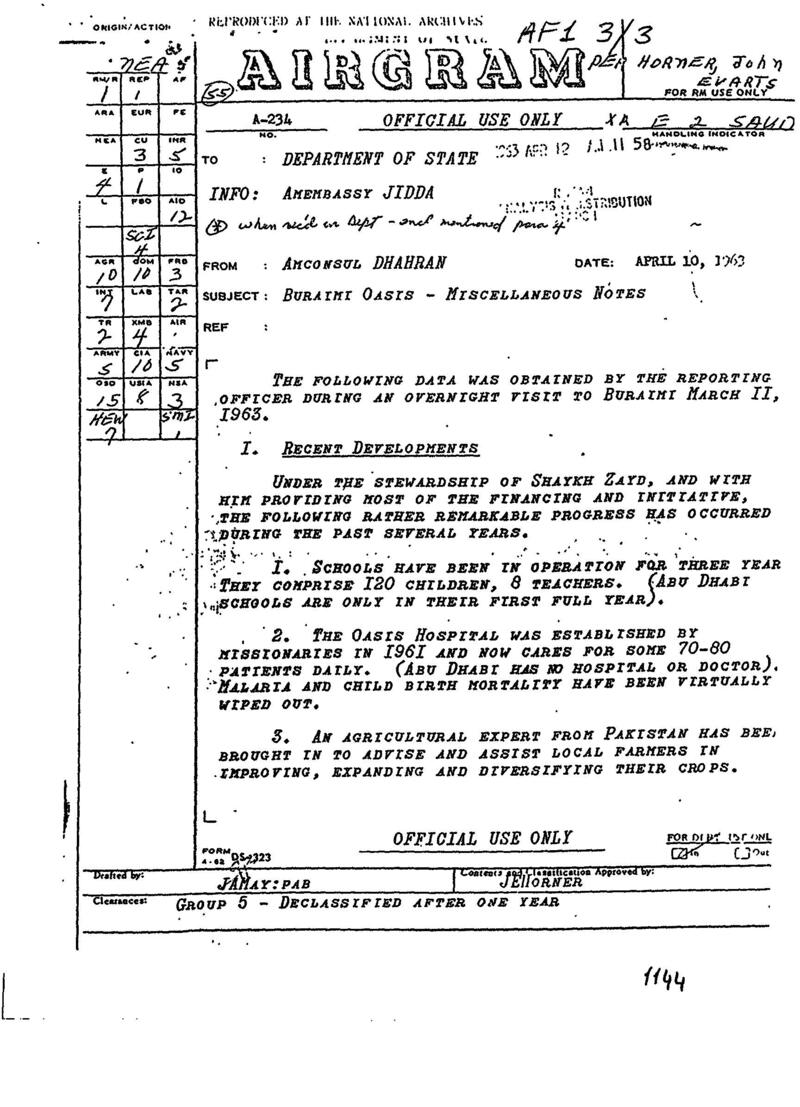
Airgram regarding data obtained during an overnight visit to Buraimi, including recent developments in the Buraimi Oasis, 10 April 1963. Courtesy of National Archives and Records Administration of Maryland USA

Memorandum of Conversation containing suggestions to the Ruler of Abu Dhabi on how to improve the current Police Force and to conduct other developments in Abu Dhabi, including educational programs, 15 July 1963. Courtesy of National Archives and Records Administration of Maryland USA

Memorandum of Conversation containing suggestions to the Ruler of Abu Dhabi on how to improve the current Police Force and to conduct other developments in Abu Dhabi, including educational programs, 15 July 1963. Courtesy of National Archives and Records Administration of Maryland USA
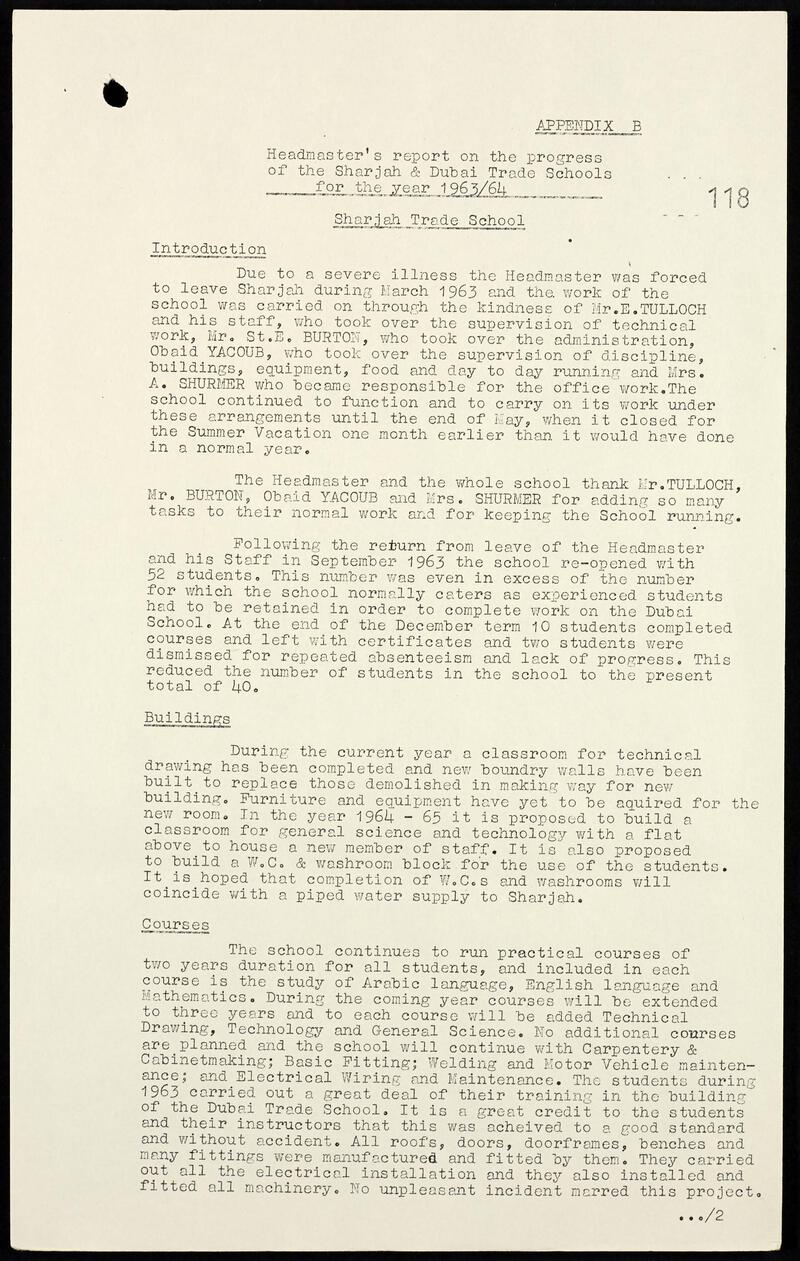
Report from John H. Taylor, Headmaster, on the progress of the Sharjah and Dubai trade schools for the year 1963, 16 June 1964. © Images reproduced by permission of The National Archives, London, England

Report from John H. Taylor, Headmaster, on the progress of the Sharjah and Dubai trade schools for the year 1963, 16 June 1964. © Images reproduced by permission of The National Archives, London, England

Report from John H. Taylor, Headmaster, on the progress of the Sharjah and Dubai trade schools for the year 1963, 16 June 1964. © Images reproduced by permission of The National Archives, London, England
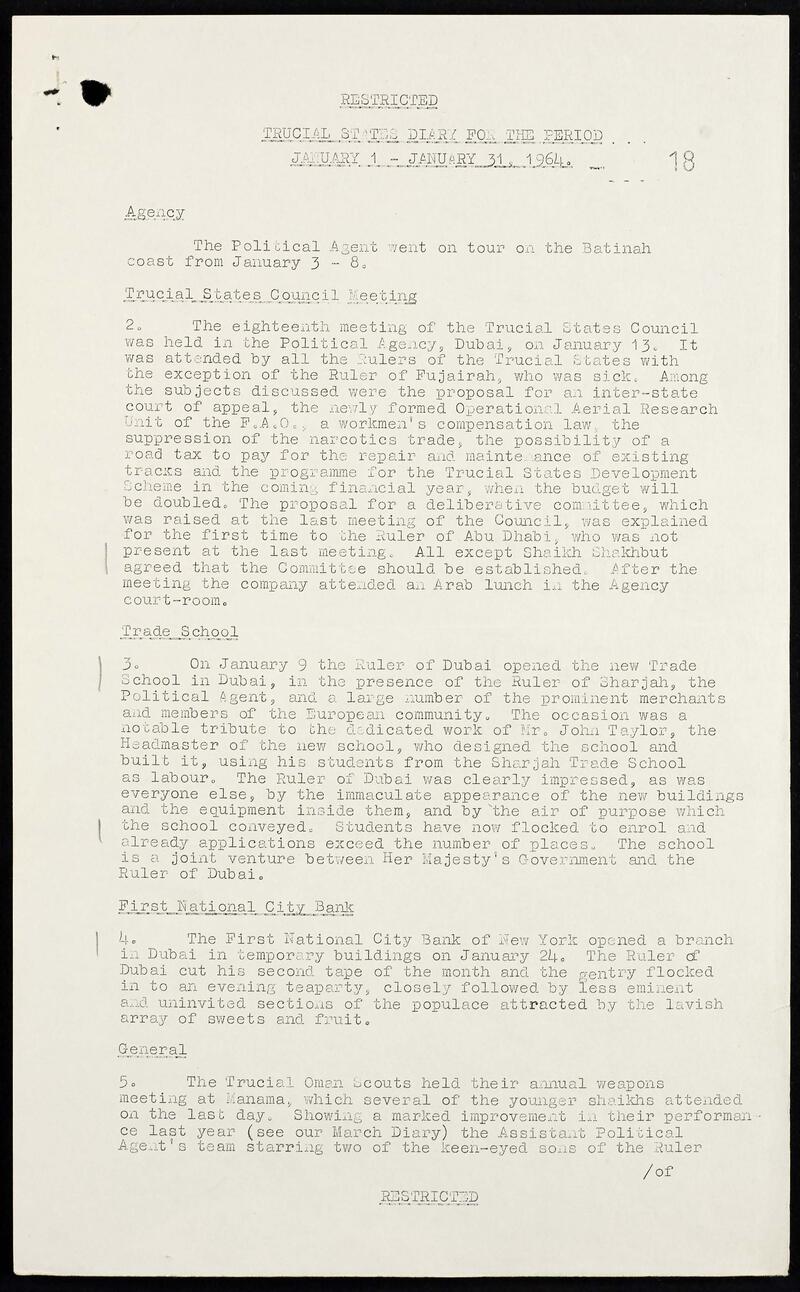
Details regarding the opening of a Trade School in Dubai on the 9th of January 1964, extracted from the Trucial States Diary, January 1964. © Images reproduced by permission of The National Archives, London, England

Opening of the first girls’ school in Abu Dhabi on the 18th of January 1964, extracted from the Trucial States Diary, January 1964. © Images reproduced by permission of The National Archives, London, England
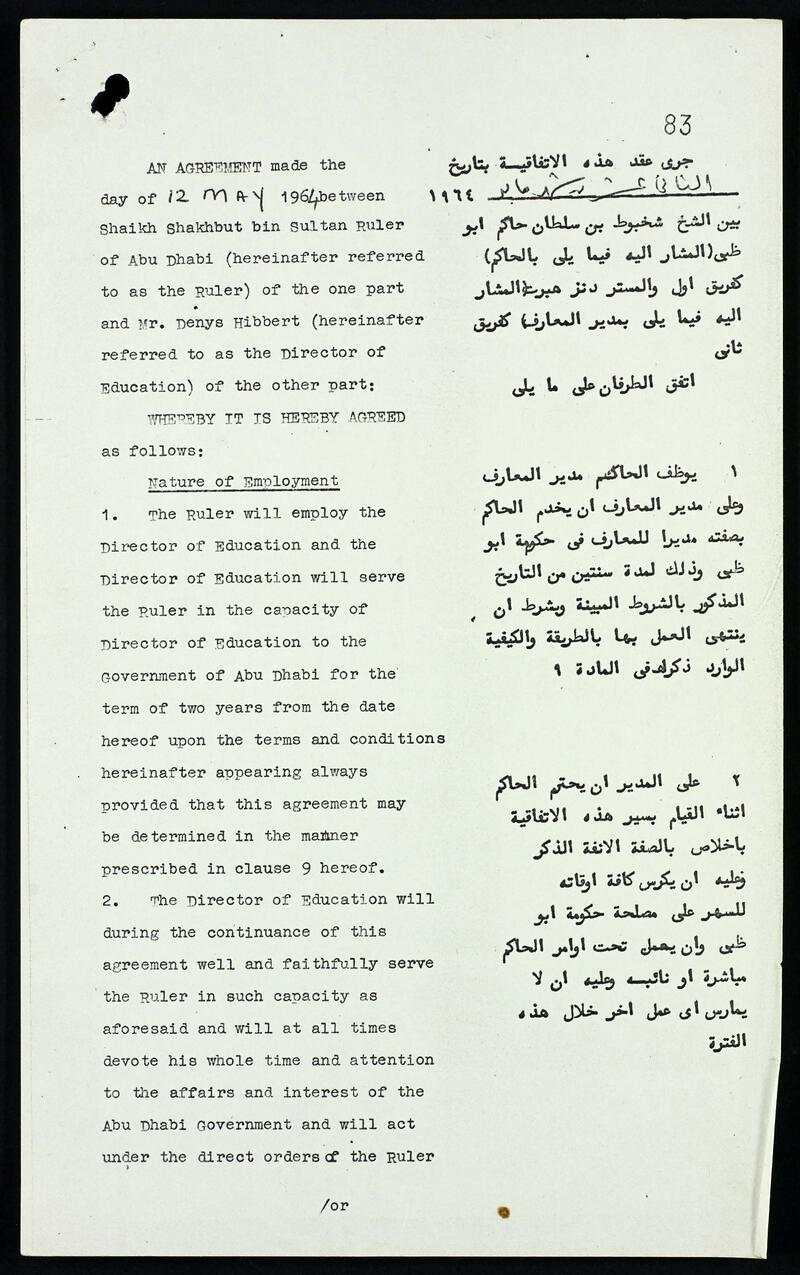
Extract from an agreement on the appointment of the Director of Education, signed by Sheikh Shakhbut Bin Sultan Al Nahyan, Ruler of Abu Dhabi, 12 May 1964. © Images reproduced by permission of The National Archives, London, England
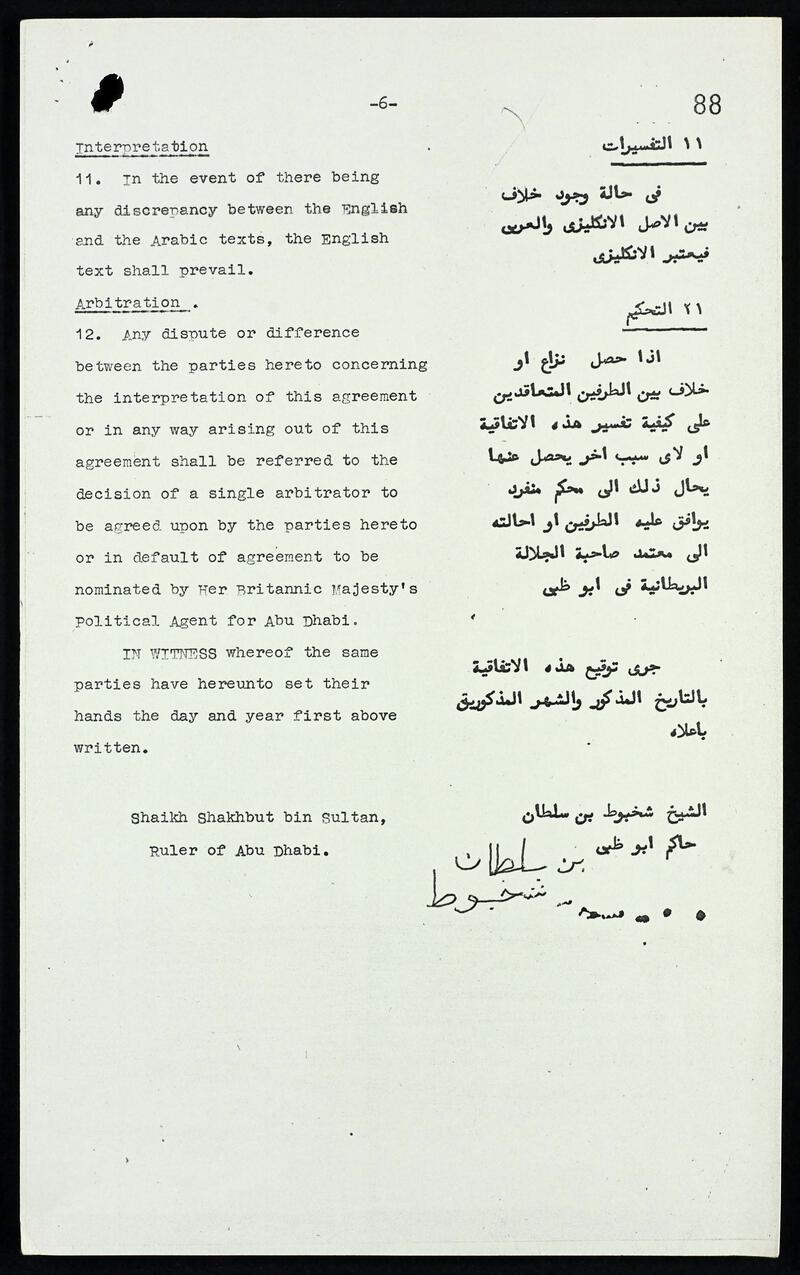
Extract from an agreement on the appointment of the Director of Education, signed by Sheikh Shakhbut Bin Sultan Al Nahyan, Ruler of Abu Dhabi, 12 May 1964. © Images reproduced by permission of The National Archives, London, England

Account of the establishment of an English-speaking school in Dubai, excerpted from the Trucial States Diary, July 1964. © Images reproduced by permission of The National Archives, London, England
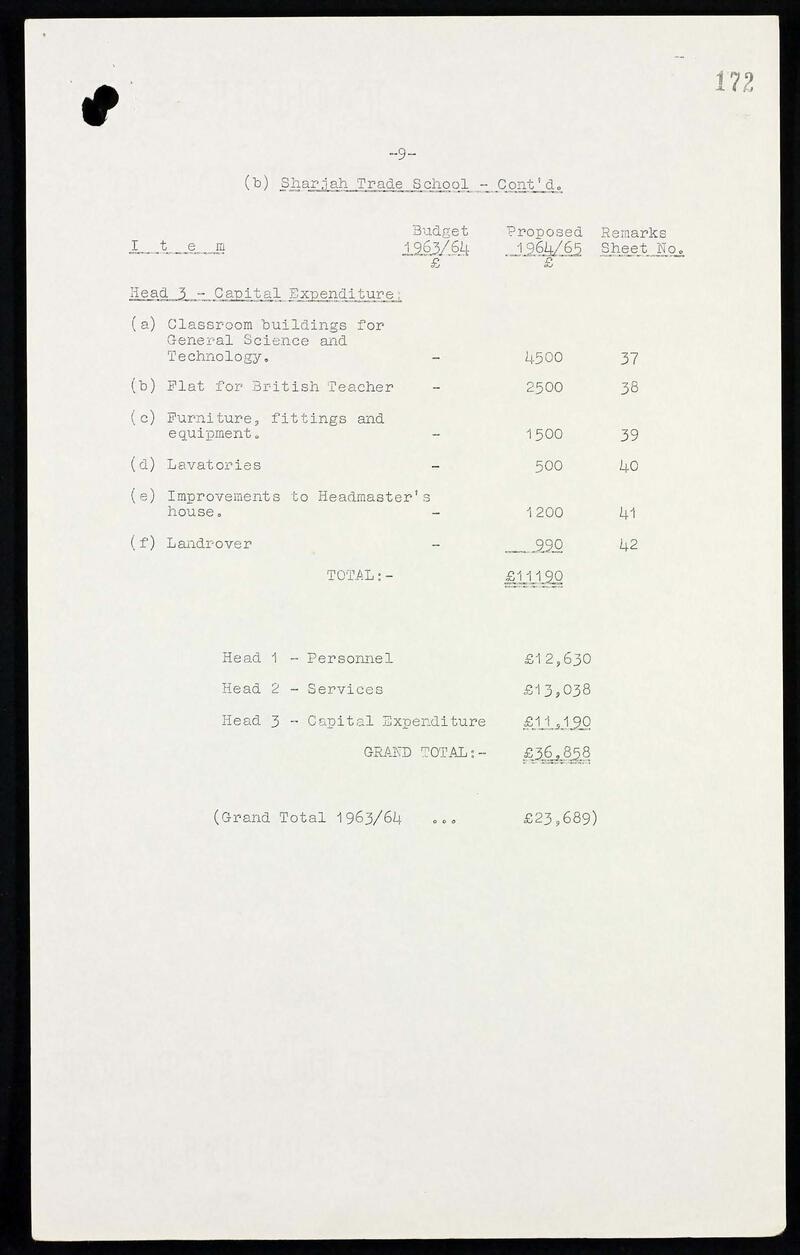
Extract from Trucial States Development Budget proposed for 1964-1965, December 1963. © Images reproduced by permission of The National Archives, London, England

Extract from Trucial States Development Budget proposed for 1964-1965, December 1963. © Images reproduced by permission of The National Archives, London, England
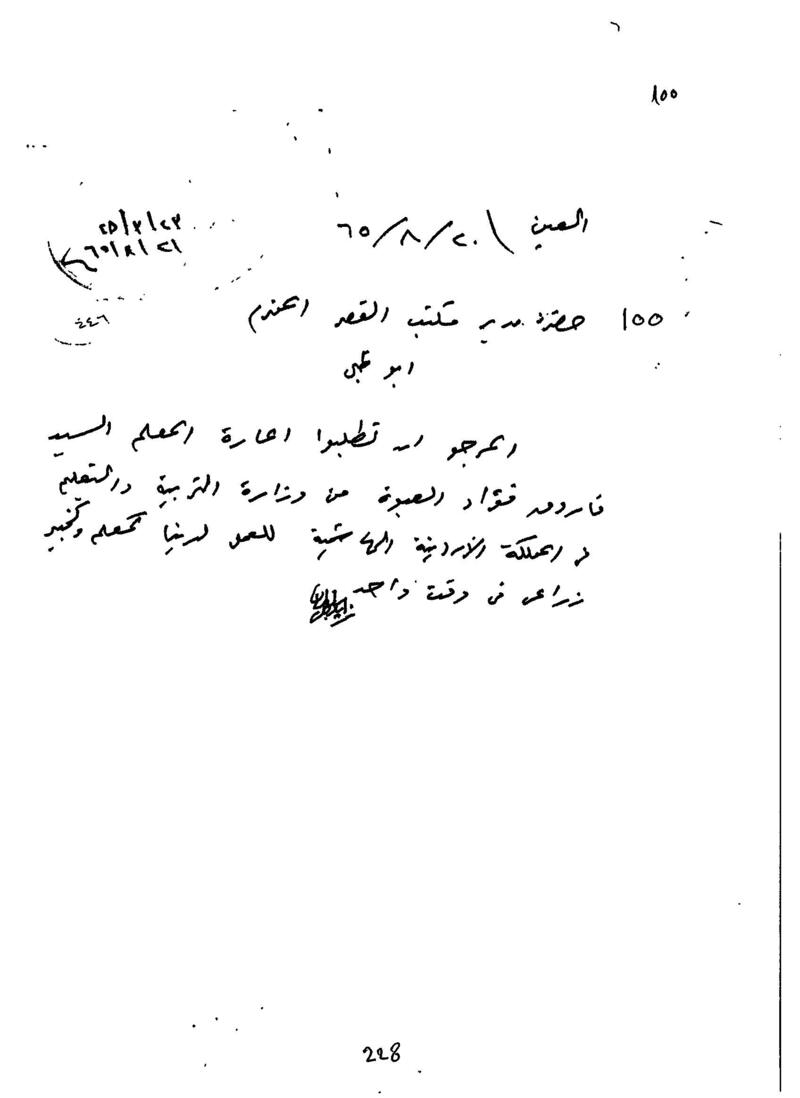
Directives from Sheikh Zayed Bin Sultan Al Nahyan to the Palace office, regarding the secondment of a technical teacher from Jordan to Al Ain, to serve as a teacher and an agriculture expert, 20 August 1965. © UAE National Library and Archives

Circular from the Director of the Knowledge Department in Abu Dhabi, to school Headmasters in Abu Dhabi, regarding renaming Al Ain school “Al Nahyania School” in Buraimi, as per the instruction of Sheikh Zayed Bin Sultan Al Nahyan, 29 December 1965. © UAE National Library and Archives

Letter from the Director of the Knowledge Department in Abu Dhabi to the Palace Office, regarding approving the Scouts Program in Al Falahia and Al Sharqia Schools, 5 January 1966. © UAE National Library and Archives

Extract from the report on education in Abu Dhabi from the British Council to Sheikh Shakhbut Bin Sultan Al Nahyan, Ruler of Abu Dhabi, 4 April 1966. © Images reproduced by permission of The National Archives, London, England
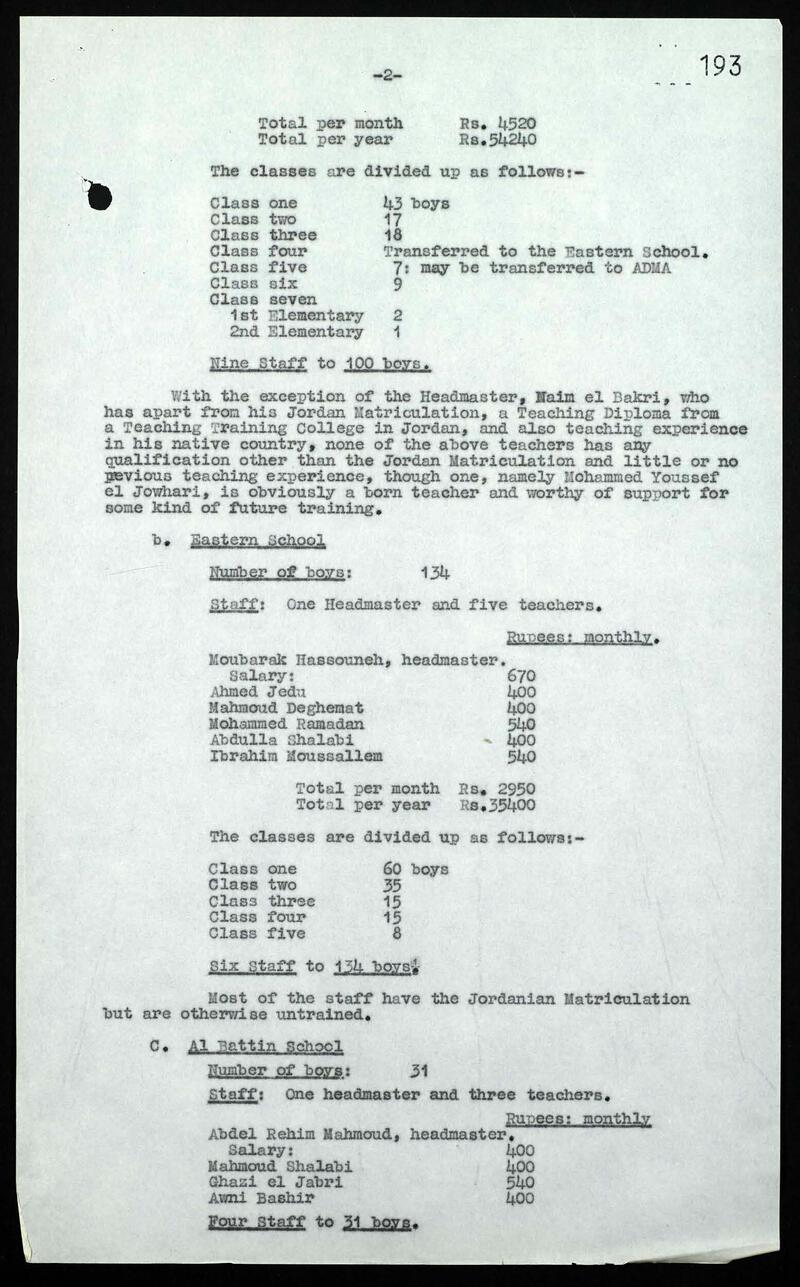
Extract from the report on education in Abu Dhabi from the British Council to Sheikh Shakhbut Bin Sultan Al Nahyan, Ruler of Abu Dhabi, 4 April 1966. © Images reproduced by permission of The National Archives, London, England

Extract from the report on education in Abu Dhabi from the British Council to Sheikh Shakhbut Bin Sultan Al Nahyan, Ruler of Abu Dhabi, 4 April 1966. © Images reproduced by permission of The National Archives, London, England
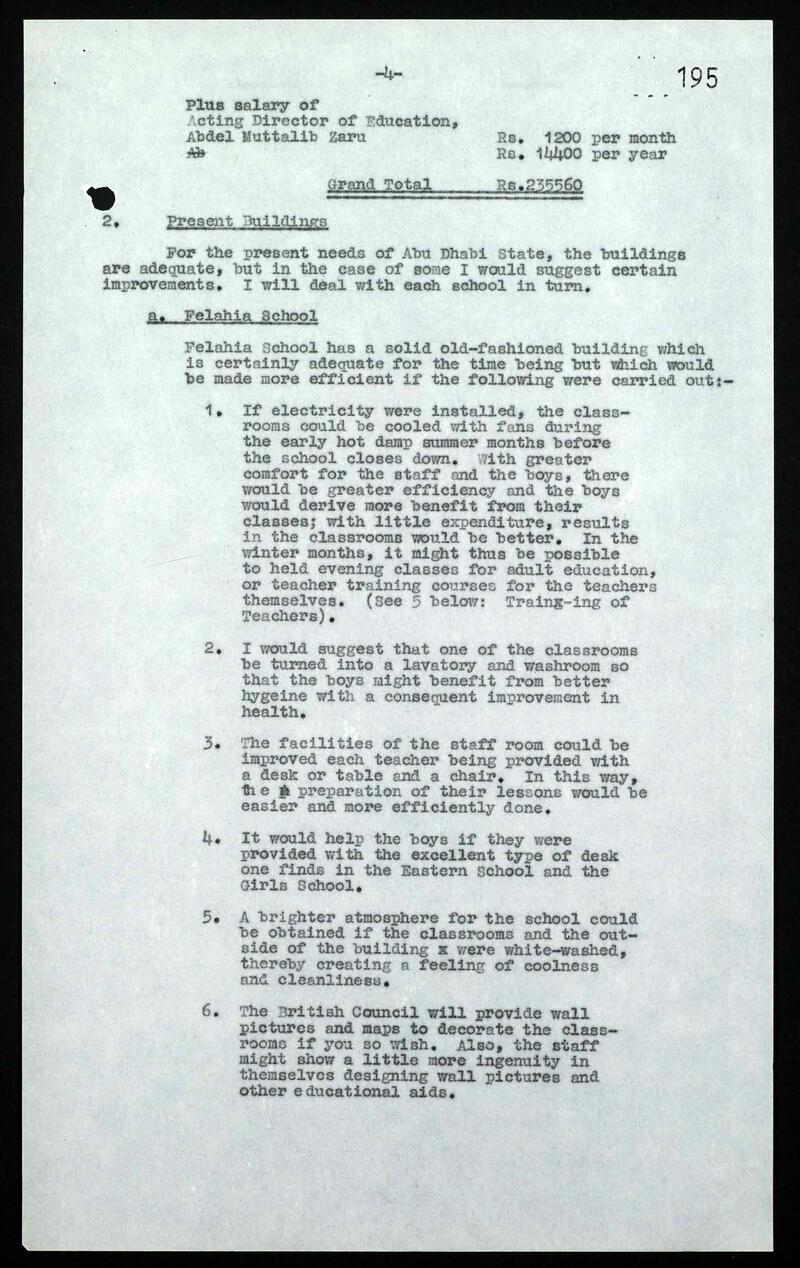
Extract from the report on education in Abu Dhabi from the British Council to Sheikh Shakhbut Bin Sultan Al Nahyan, Ruler of Abu Dhabi, 4 April 1966. © Images reproduced by permission of The National Archives, London, England

Extract from the report on education in Abu Dhabi from the British Council to Sheikh Shakhbut Bin Sultan Al Nahyan, Ruler of Abu Dhabi, 4 April 1966. © Images reproduced by permission of The National Archives, London, England
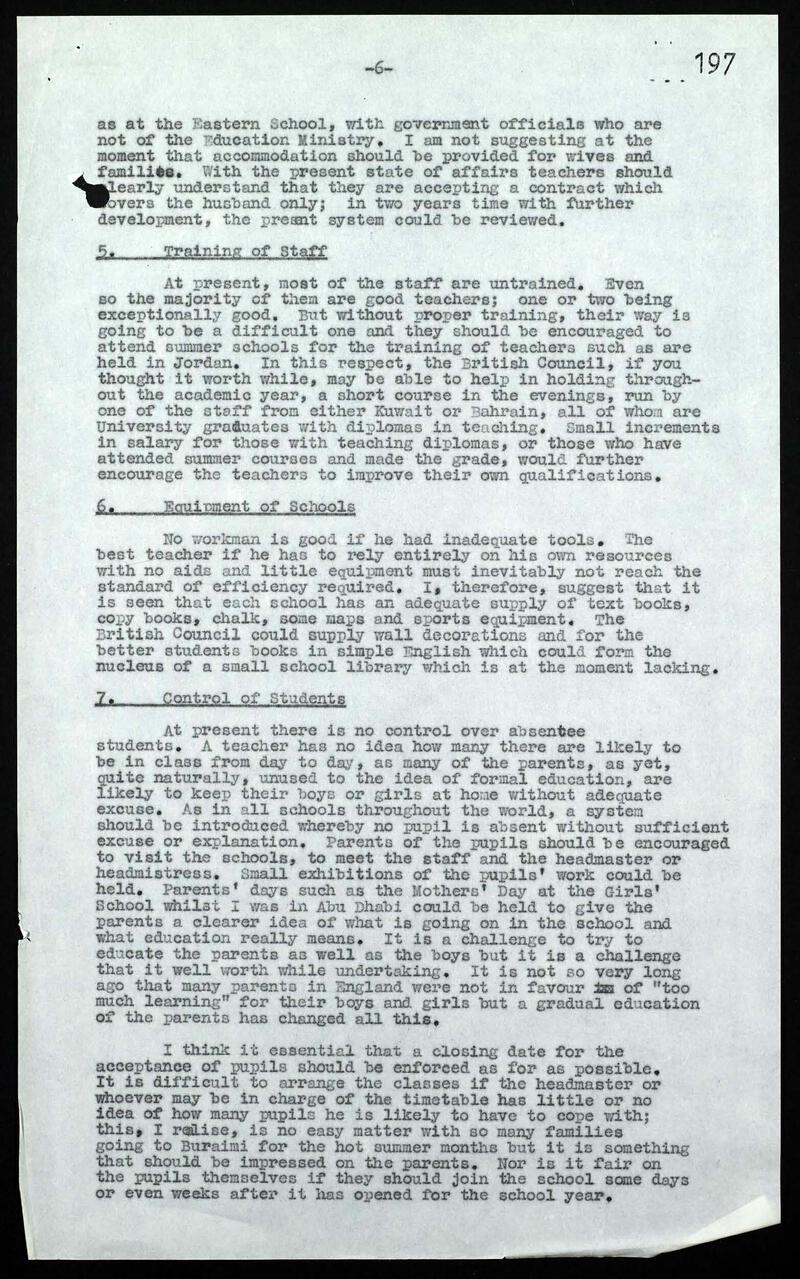
Extract from the report on education in Abu Dhabi from the British Council to Sheikh Shakhbut Bin Sultan Al Nahyan, Ruler of Abu Dhabi, 4 April 1966. © Images reproduced by permission of The National Archives, London, England
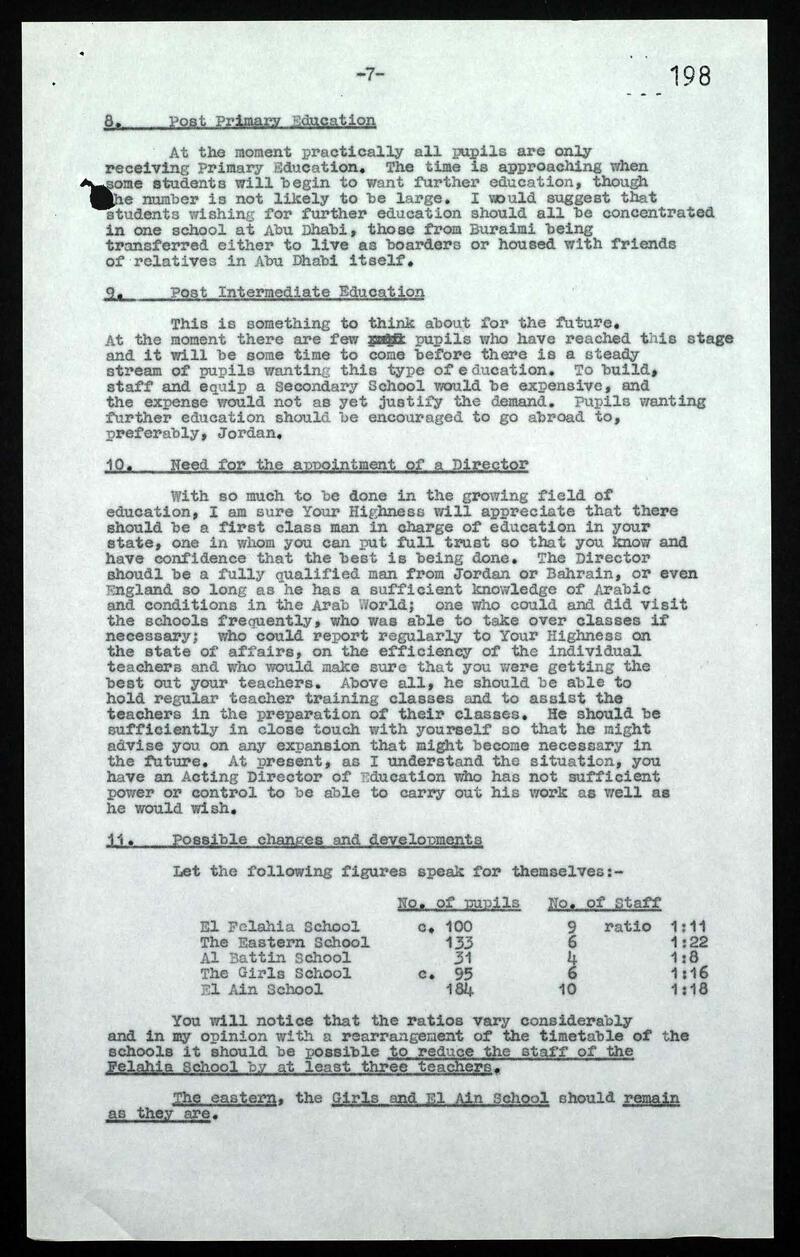
Extract from the report on education in Abu Dhabi from the British Council to Sheikh Shakhbut Bin Sultan Al Nahyan, Ruler of Abu Dhabi, 4 April 1966. © Images reproduced by permission of The National Archives, London, England
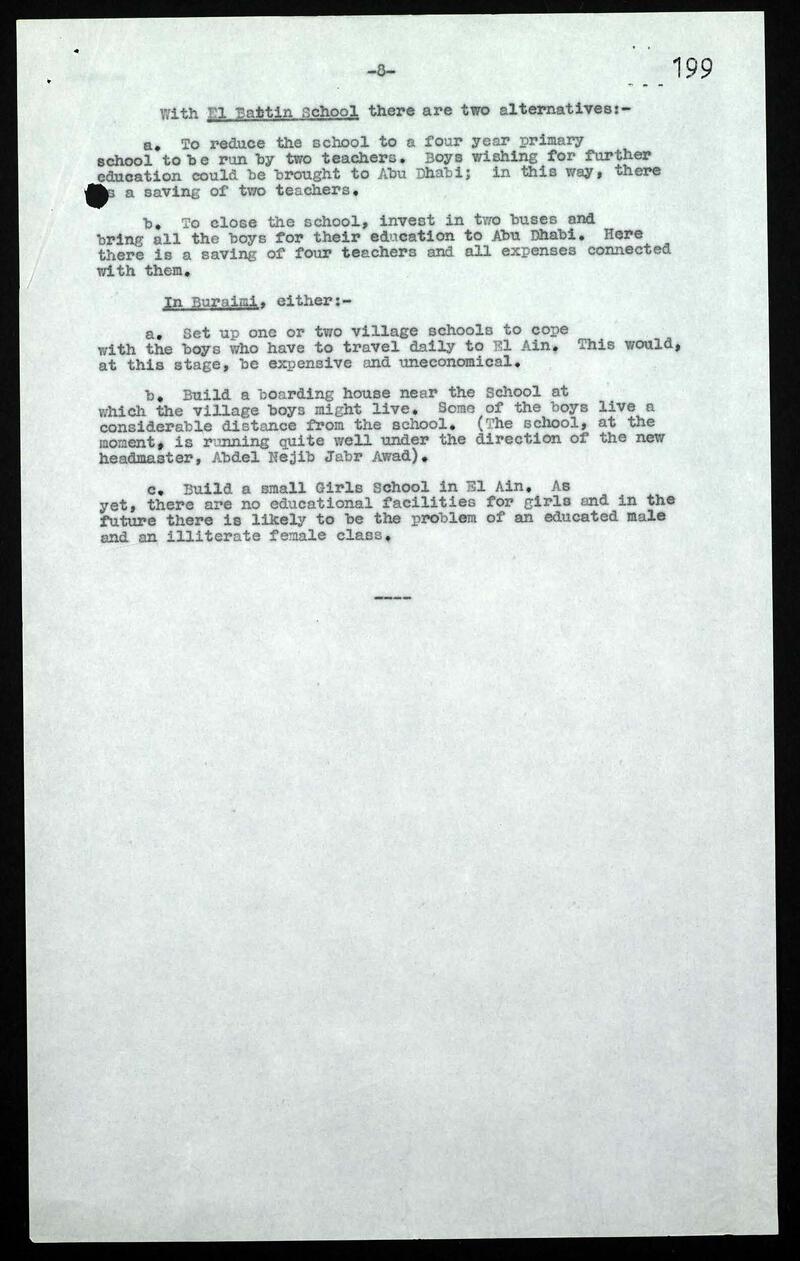
Extract from the report on education in Abu Dhabi from the British Council to Sheikh Shakhbut Bin Sultan Al Nahyan, Ruler of Abu Dhabi, 4 April 1966. © Images reproduced by permission of The National Archives, London, England
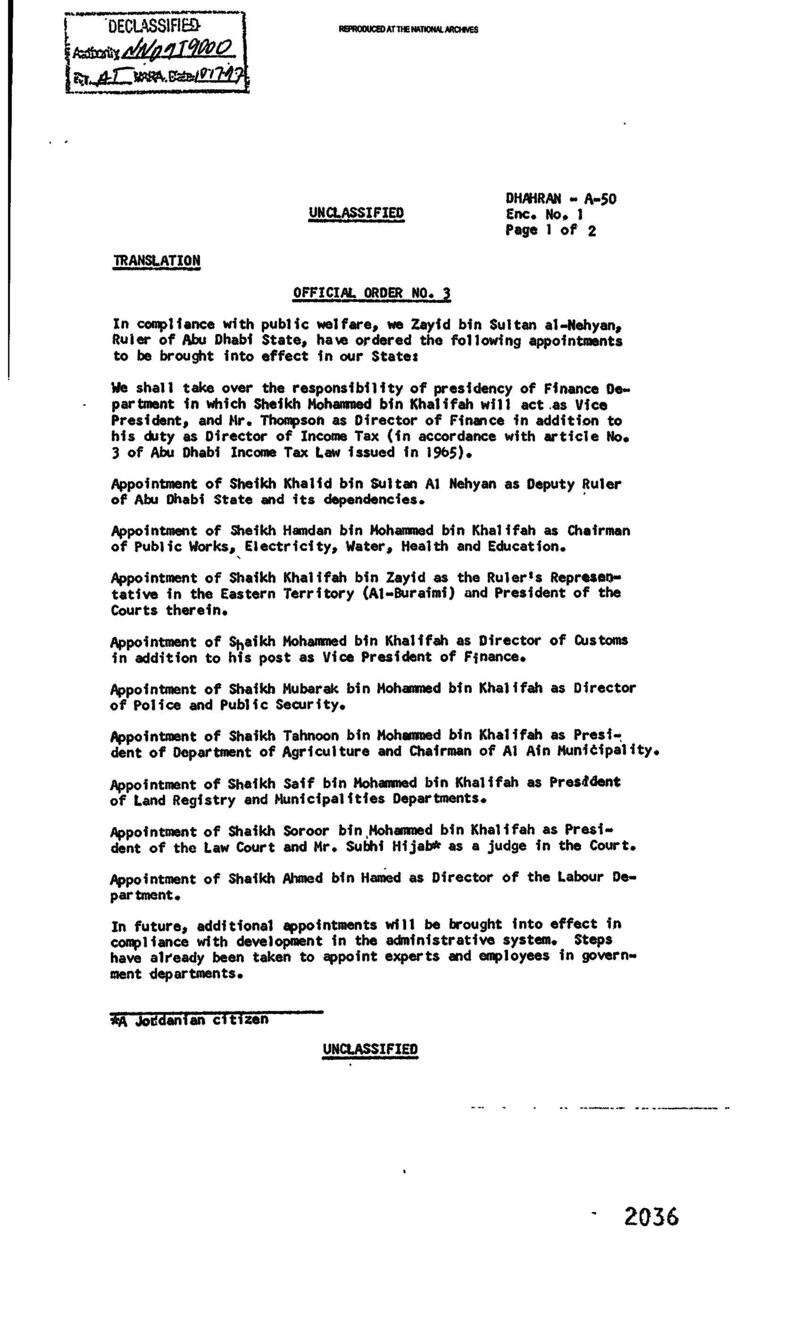
Translation of Official Order No.3 issued by Sheikh Zayed Bin Sultan Al Nahyan on the formation of the new government, 19 October 1966. Courtesy of National Archives and Records Administration of Maryland USA

Translation of Official Order No.3 issued by Sheikh Zayed Bin Sultan Al Nahyan on the formation of the new government, 19 October 1966. Courtesy of National Archives and Records Administration of Maryland USA
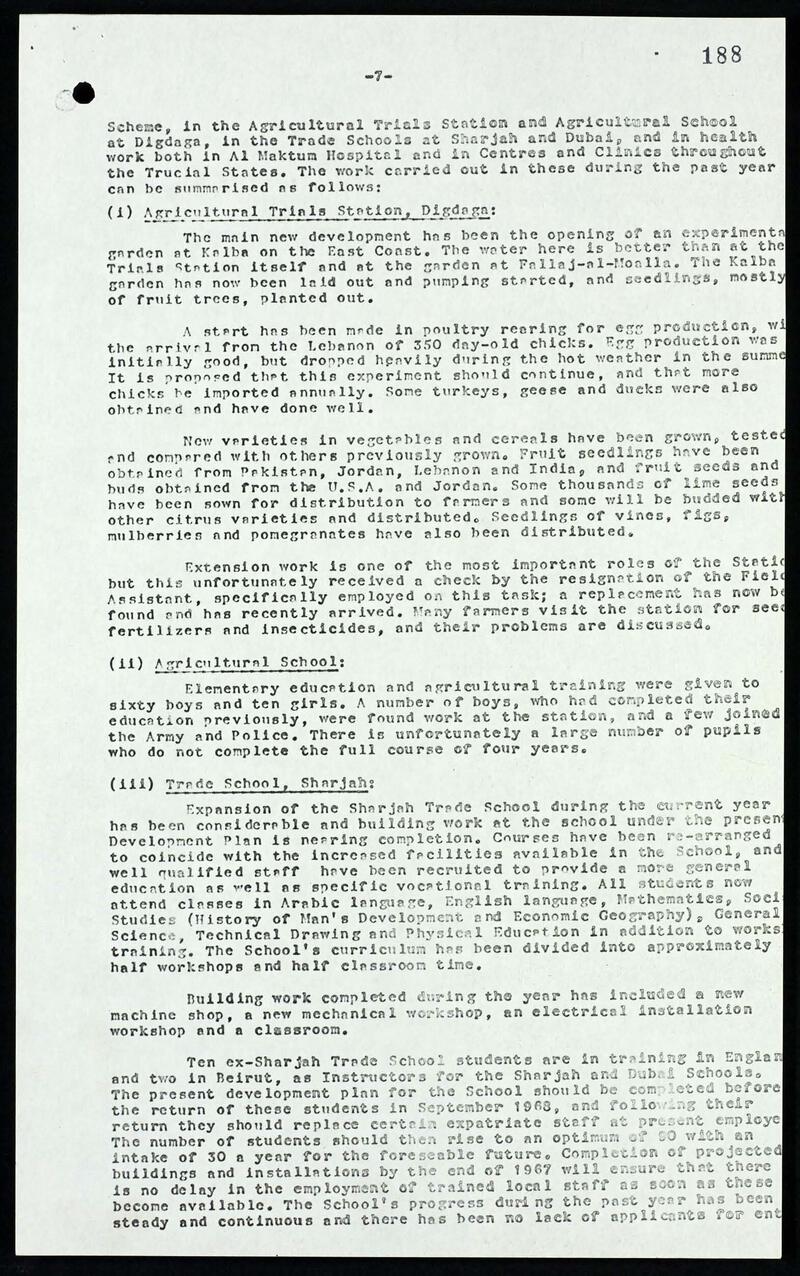
Extract on education from the Trucial States Development Fund Report, 1966. © Images reproduced by permission of The National Archives, London, England

Extract on education from the Trucial States Development Fund Report, 1966. © Images reproduced by permission of The National Archives, London, England
Students reciting the Holy Quran at the new school for boys in Abu Dhabi, 1966. © BP plc
Boys at play outside their school in Al Ain, 1966. © BP plc
Girls at play at their school in Abu Dhabi, 1966. © BP plc
Boy scouts lined up in a courtyard in Abu Dhabi, March 1967. Source: UAE National Library and Archives

Extract from notes on Education in the Lower Gulf by G. Mollison, Adviser on Technical Education, Middle East Development Division, 5 April 1967. © Images reproduced by permission of The National Archives, London, England

Extract from notes on Education in the Lower Gulf by G. Mollison, Adviser on Technical Education, Middle East Development Division, 5 April 1967. © Images reproduced by permission of The National Archives, London, England

Extract from notes on Education in the Lower Gulf by G. Mollison, Adviser on Technical Education, Middle East Development Division, 5 April 1967. © Images reproduced by permission of The National Archives, London, England

Extract from notes on Education in the Lower Gulf by G. Mollison, Adviser on Technical Education, Middle East Development Division, 5 April 1967. © Images reproduced by permission of The National Archives, London, England

Plan for seven phases in the development of education in the state of Abu Dhabi, prepared by Dr. Harold Spencer, Director of Education, Abu Dhabi, 4 July 1967. © Images reproduced by permission of The National Archives, London, England

Plan for seven phases in the development of education in the state of Abu Dhabi, prepared by Dr. Harold Spencer, Director of Education, Abu Dhabi, 4 July 1967. © Images reproduced by permission of The National Archives, London, England

Plan for seven phases in the development of education in the state of Abu Dhabi, prepared by Dr. Harold Spencer, Director of Education, Abu Dhabi, 4 July 1967. © Images reproduced by permission of The National Archives, London, England

Extract about Trade Schools from the report by Sheikh Saqr Bin Mohammad Al Qasimi, Chairman of the Trucial States Council, submitted to the Trucial Council’s meeting in Dubai, 29 August 1967. © Images reproduced by permission of The National Archives, London, England

Extract about Trade Schools from the report by Sheikh Saqr Bin Mohammad Al Qasimi, Chairman of the Trucial States Council, submitted to the Trucial Council’s meeting in Dubai, 29 August 1967. © Images reproduced by permission of The National Archives, London, England
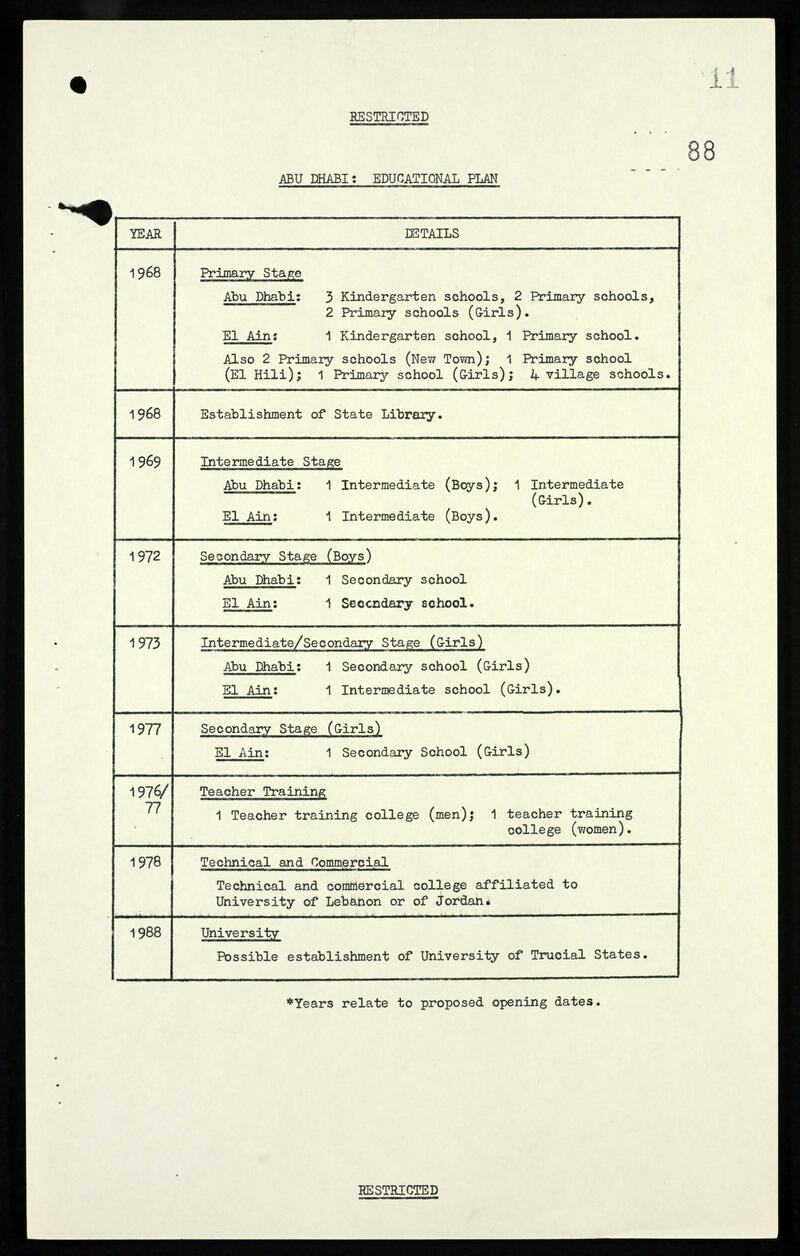
Extract on education, from a report on labour, social and industrial developments in Abu Dhabi by British Embassy in Beirut, 16 December 1967. © Images reproduced by permission of The National Archives, London, England
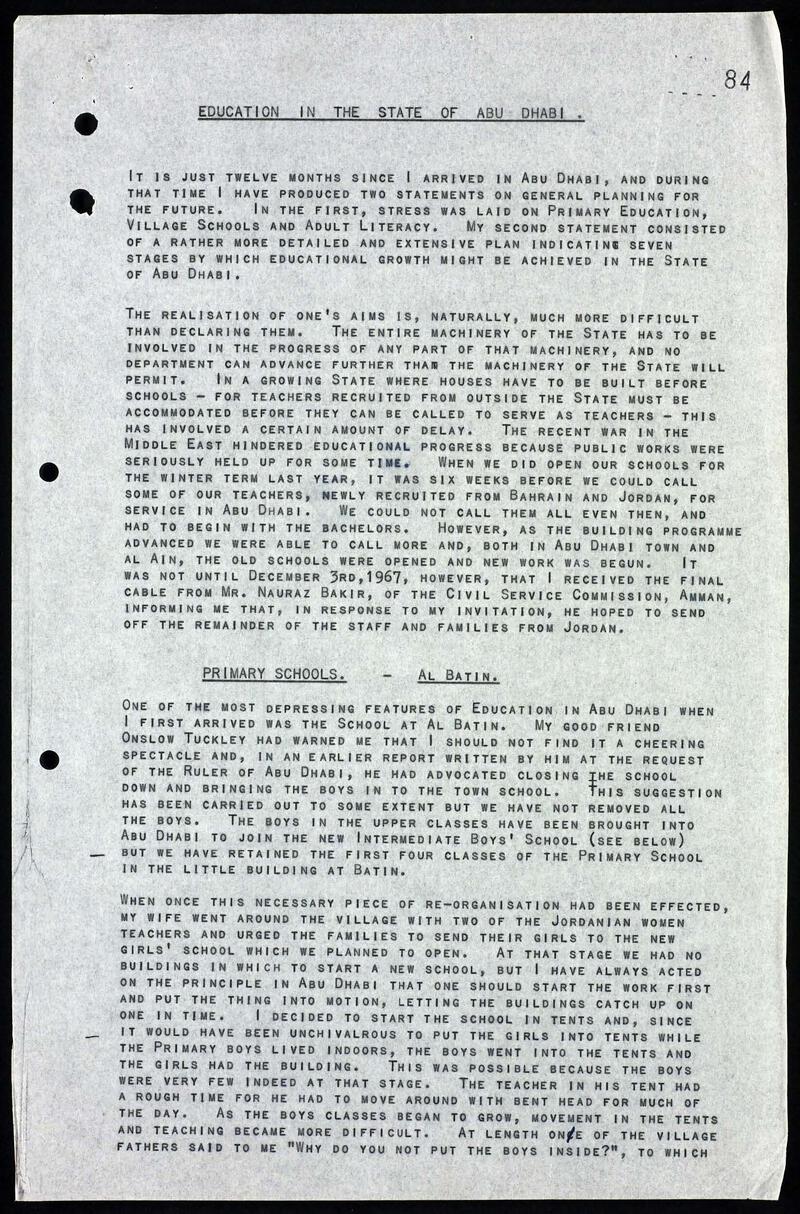
Extract from a report on education in Abu Dhabi by Dr. Harold Spencer, Director of Education, Abu Dhabi, 24 March 1968. © Images reproduced by permission of The National Archives, London, England

Extract from a report on education in Abu Dhabi by Dr. Harold Spencer, Director of Education, Abu Dhabi, 24 March 1968. © Images reproduced by permission of The National Archives, London, England
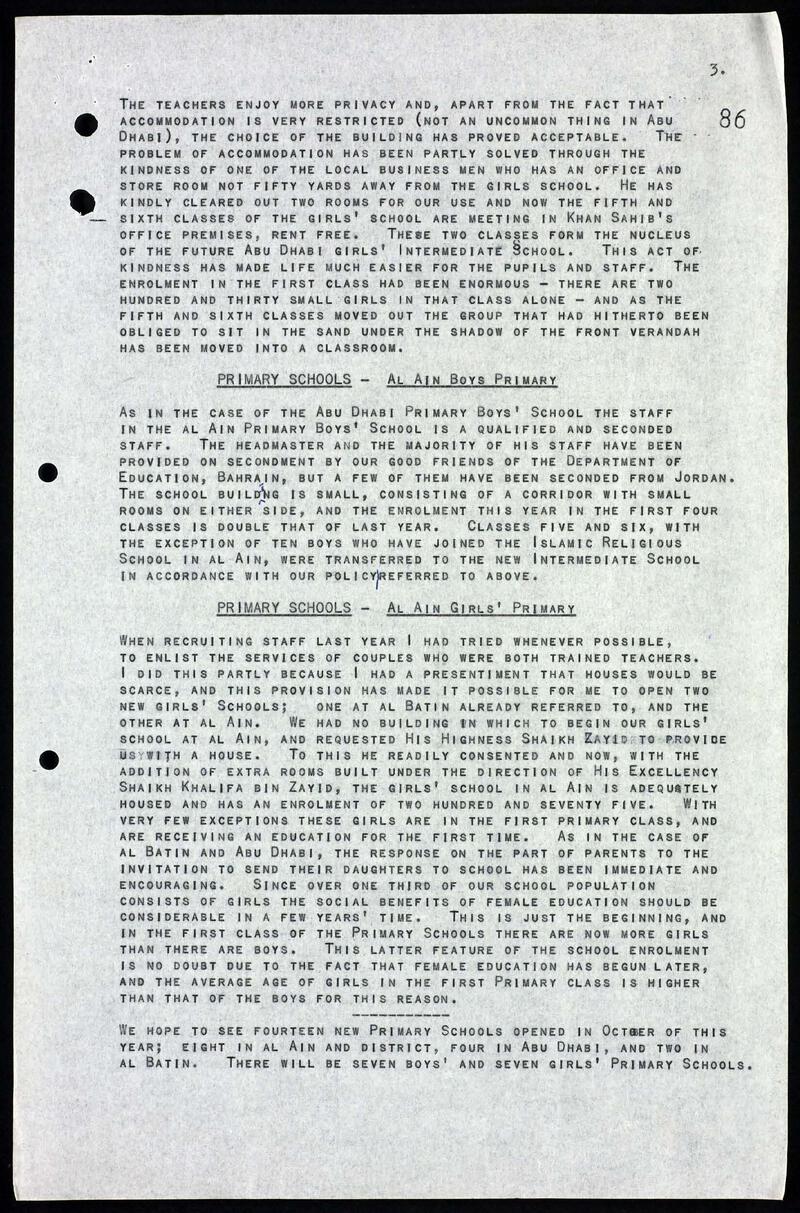
Extract from a report on education in Abu Dhabi by Dr. Harold Spencer, Director of Education, Abu Dhabi, 24 March 1968. © Images reproduced by permission of The National Archives, London, England

Extract from a report on education in Abu Dhabi by Dr. Harold Spencer, Director of Education, Abu Dhabi, 24 March 1968. © Images reproduced by permission of The National Archives, London, England
Sheikh Zayed Bin Sultan Al Nahyan at the official inauguration of Al Khubairat School, Abu Dhabi, May 1968. © Barbara Clarke

Extract from the Five Year Development Plan for the period 1968-1972 for Abu Dhabi, 17 July 1968. Courtesy of National Archives and Records Administration of Maryland USA
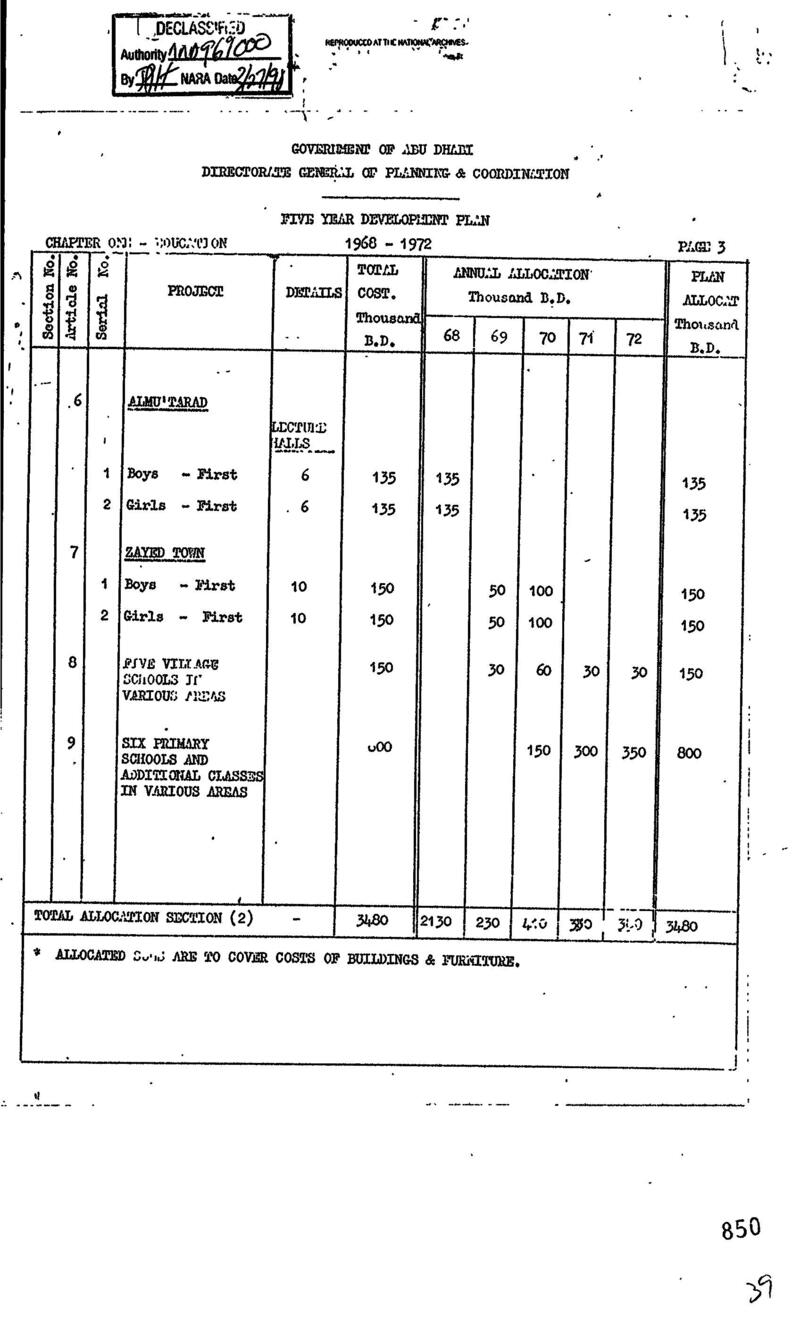
Extract from the Five Year Development Plan for the period 1968-1972 for Abu Dhabi, 17 July 1968. Courtesy of National Archives and Records Administration of Maryland USA

Extract from the Five Year Development Plan for the period 1968-1972 for Abu Dhabi, 17 July 1968. Courtesy of National Archives and Records Administration of Maryland USA
Promoting Women’s education in Al Ain, 1968. © UAE National Library and Archives
Promoting Women’s education in Al Ain, 1968. © UAE National Library and Archives
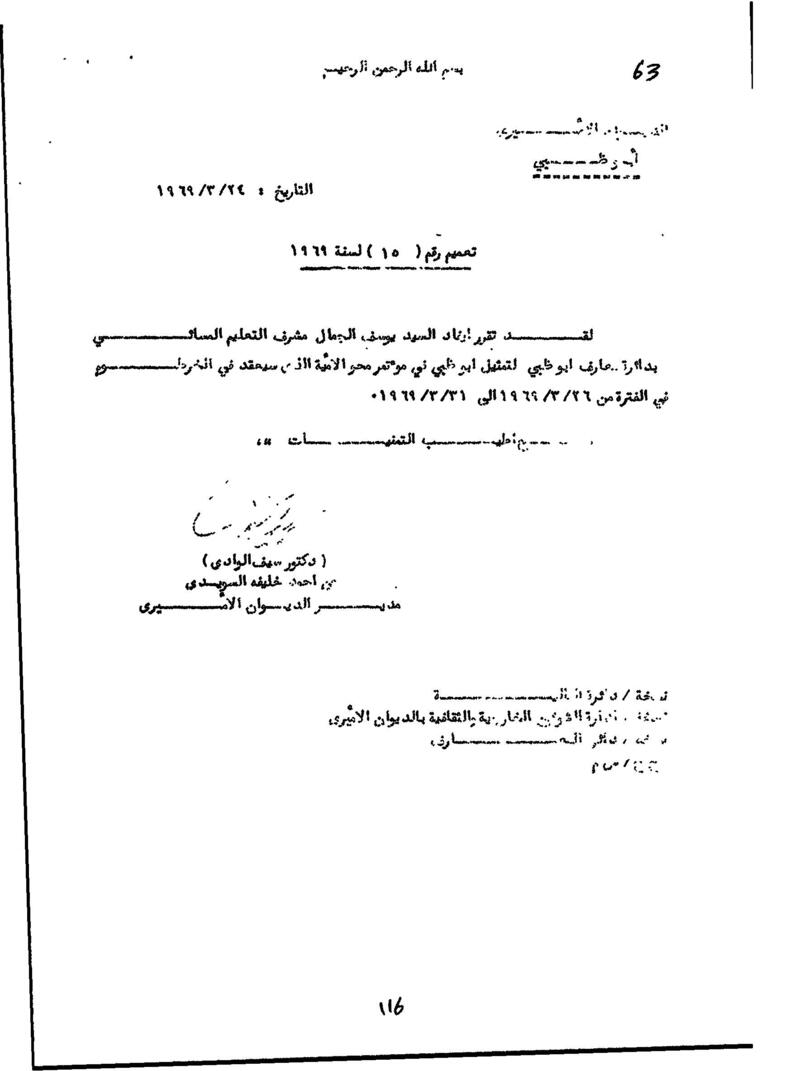
Circular no. 15 issued by the Chairman of the Emiri Diwan to the Department of Finance, the Knowledge Department, and the Emiri Diwan’s Ministry of Foreign and Cultural Affairs, regarding the delegation of Yousef Al Jamal, Night School Supervisor at the Knowledge Department, to represent Abu Dhabi at the Literacy Conference, 23 March 1969. © UAE National Library and Archives

Telegram from Political Agency, Abu Dhabi to Foreign Office, London about information on English language schools in Abu Dhabi, 14 June 1969. © Images reproduced by permission of The National Archives, London, England
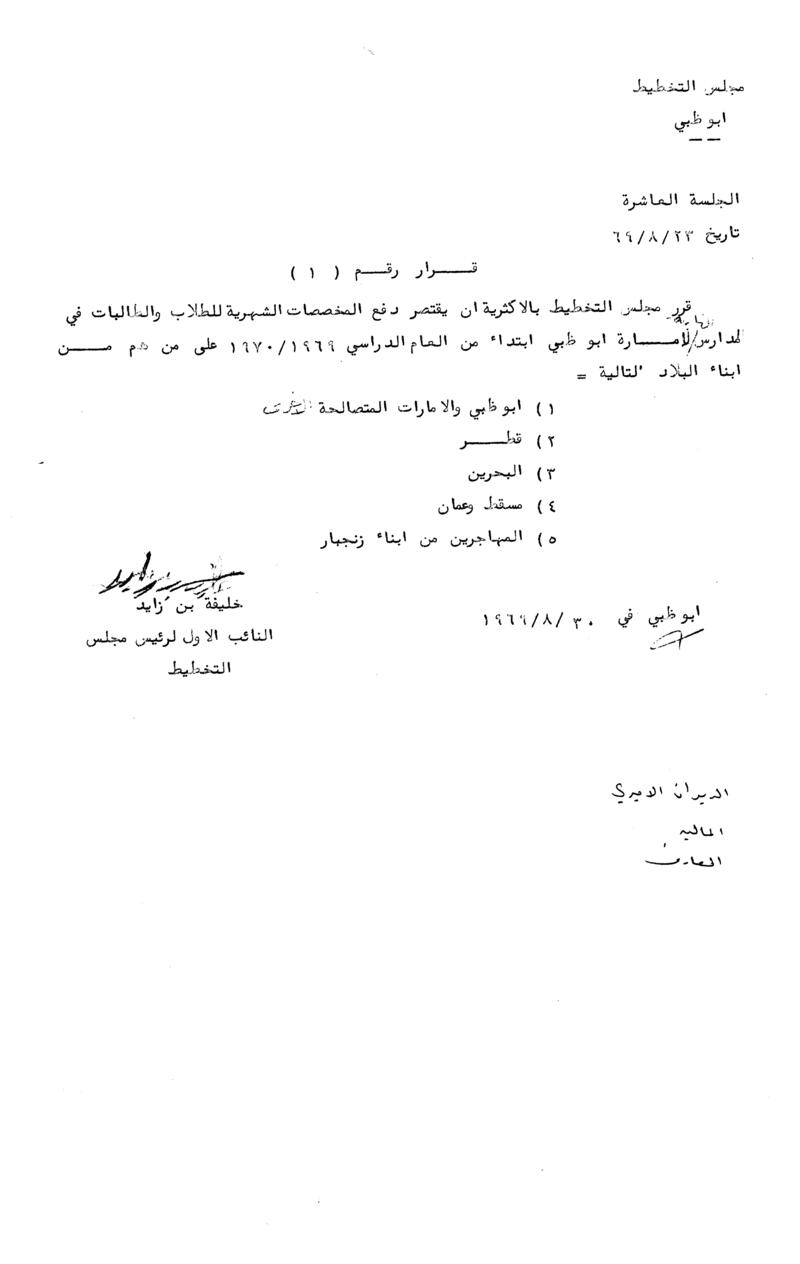
Decision issued by the Planning Council on covering monthly tuition fees for certain categories of students in Abu Dhabi schools over the period 1969-1970, 30 August 1969. © UAE National Library and Archives

Newspaper article on the development of education in Abu Dhabi, and the increase in the number of students due to the recruitment of teachers from Arab countries, 1 October 1969. © Al Ittihad Newspaper

Newspaper article on the Knowledge Department inaugurating 14 literacy centers, 13 November 1969. © Al Ittihad Newspaper

Draft Federal Law of 1969 concerning the establishment of a Federal Education Administration for the Union of Arab Emirates, 1969. © Images reproduced by permission of The National Archives, London, England

Draft Federal Law of 1969 concerning the establishment of a Federal Education Administration for the Union of Arab Emirates, 1969. © Images reproduced by permission of The National Archives, London, England

Draft Federal Law of 1969 concerning the establishment of a Federal Education Administration for the Union of Arab Emirates, 1969. © Images reproduced by permission of The National Archives, London, England

Newspaper article on the Knowledge Department announces accepting registration for high school diploma examination, 1 January 1970. © Al Ittihad Newspaper
Students at one of the schools in Al Ain, May 1970. © UAE National Library and Archives

Telegram regarding the visit of Sheikh Zayed Bin Sultan Al Nahyan, Ruler of Abu Dhabi, to Tehran to discuss cultural and economic relations, 20 May 1970. Courtesy of National Archives and Records Administration of Maryland USA
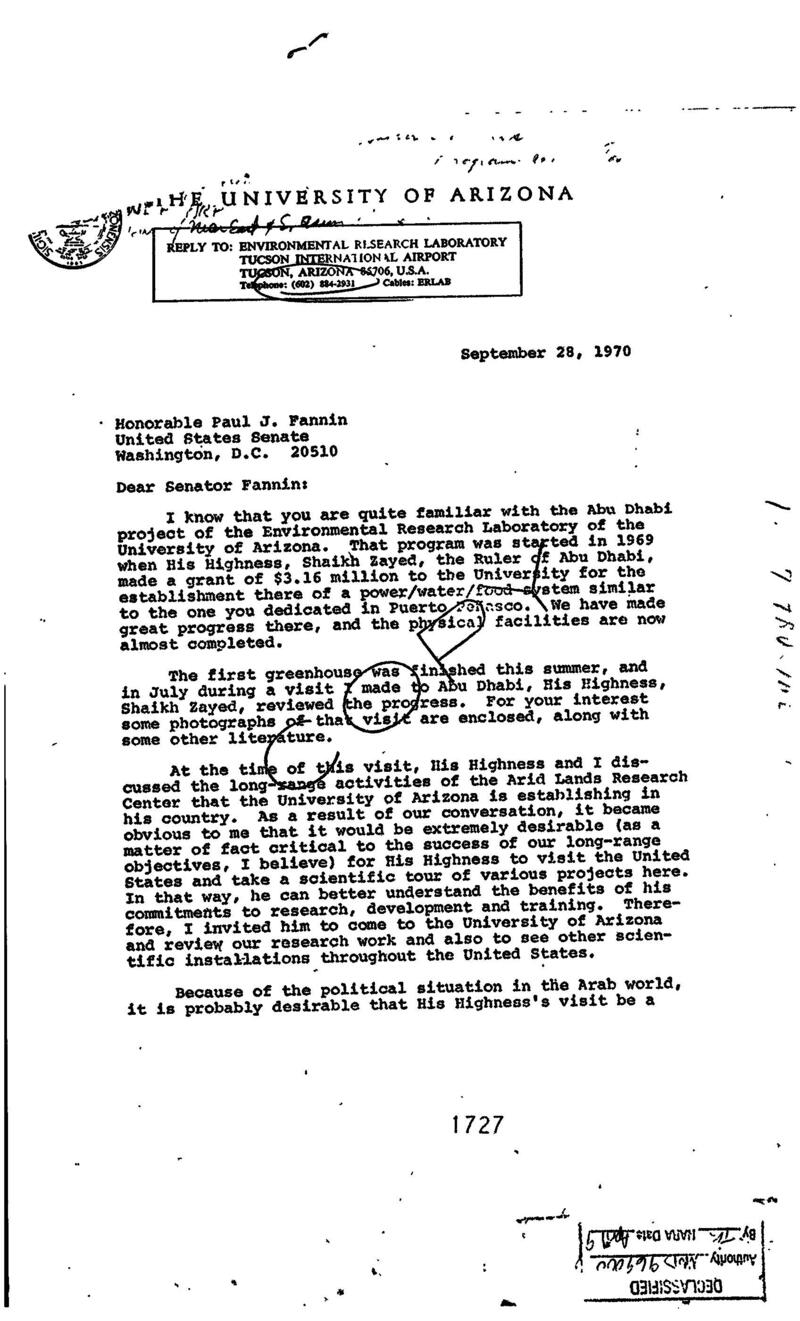
Telegram pertaining to the Environmental Research Laboratory of the University of Arizona, Sheikh Zayed Bin Sultan Al Nahyan's contribution, and his desirable visit to the United States, 28 September 1970. Courtesy of National Archives and Records Administration of Maryland USA

Telegram pertaining to the Environmental Research Laboratory of the University of Arizona, Sheikh Zayed Bin Sultan Al Nahyan's contribution, and his desirable visit to the United States, 28 September 1970. Courtesy of National Archives and Records Administration of Maryland USA

Telegram pertaining to the Environmental Research Laboratory of the University of Arizona, Sheikh Zayed Bin Sultan Al Nahyan's contribution, and his desirable visit to the United States, 28 September 1970. Courtesy of National Archives and Records Administration of Maryland USA
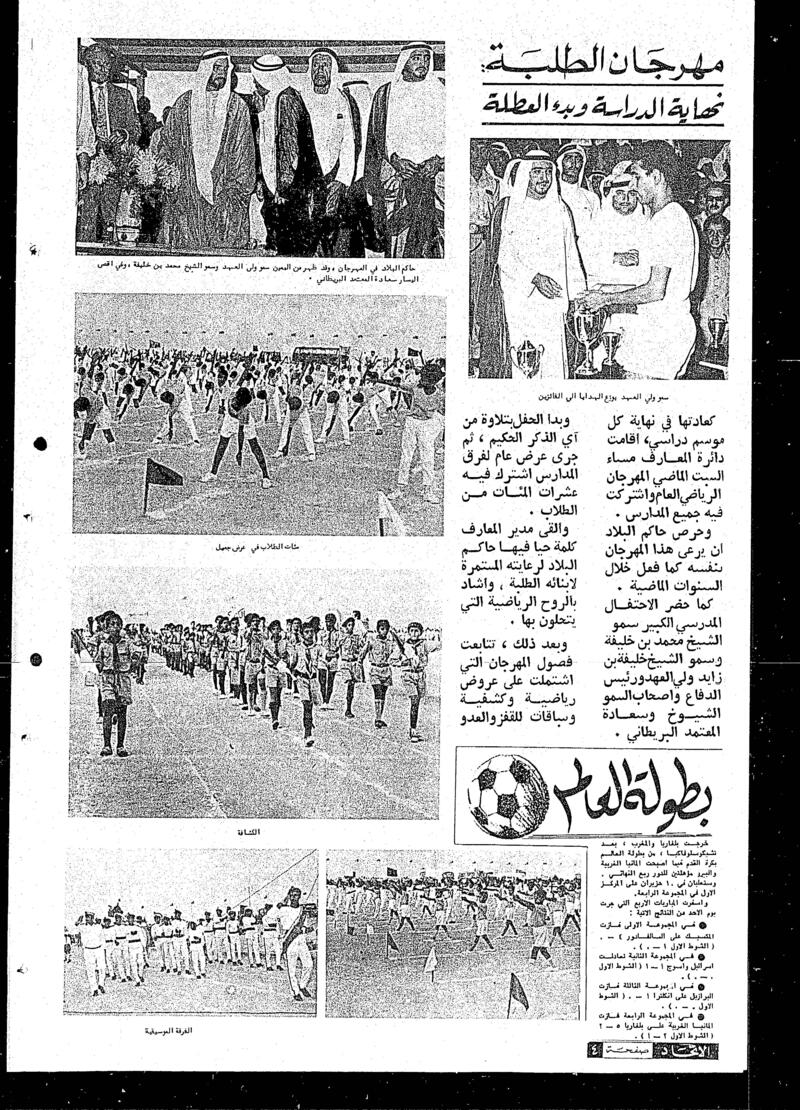
Newspaper article on the students’ festival, 11 June 1970. © Al Ittihad Newspaper
Sheikh Zayed Bin Sultan Al Nahyan accompanied by his son, Sheikh Hamdan Bin Zayed Al Nahyan, touring an exhibition by the Knowledge Department where he examines student exhibits from Jaber Bin Hayyan School in Abu Dhabi, 27 April 1971. © UAE National Library and Archives
A primary school in Sharjah, November 1971. © Associated Press
School girls in their classroom in Abu Dhabi, November 1971. © UAE National Library and Archives
Students leaving a girls school in Abu Dhabi, November 1971. © UAE National Library and Archives
Students in the laboratory at Um Ammar High School in Abu Dhabi, 25 November 1971. © Al Ittihad Newspaper

Newspaper article on media interview with the UAE President: With education, we shall build this nation, 30 December 1971. © Al Ittihad Newspaper
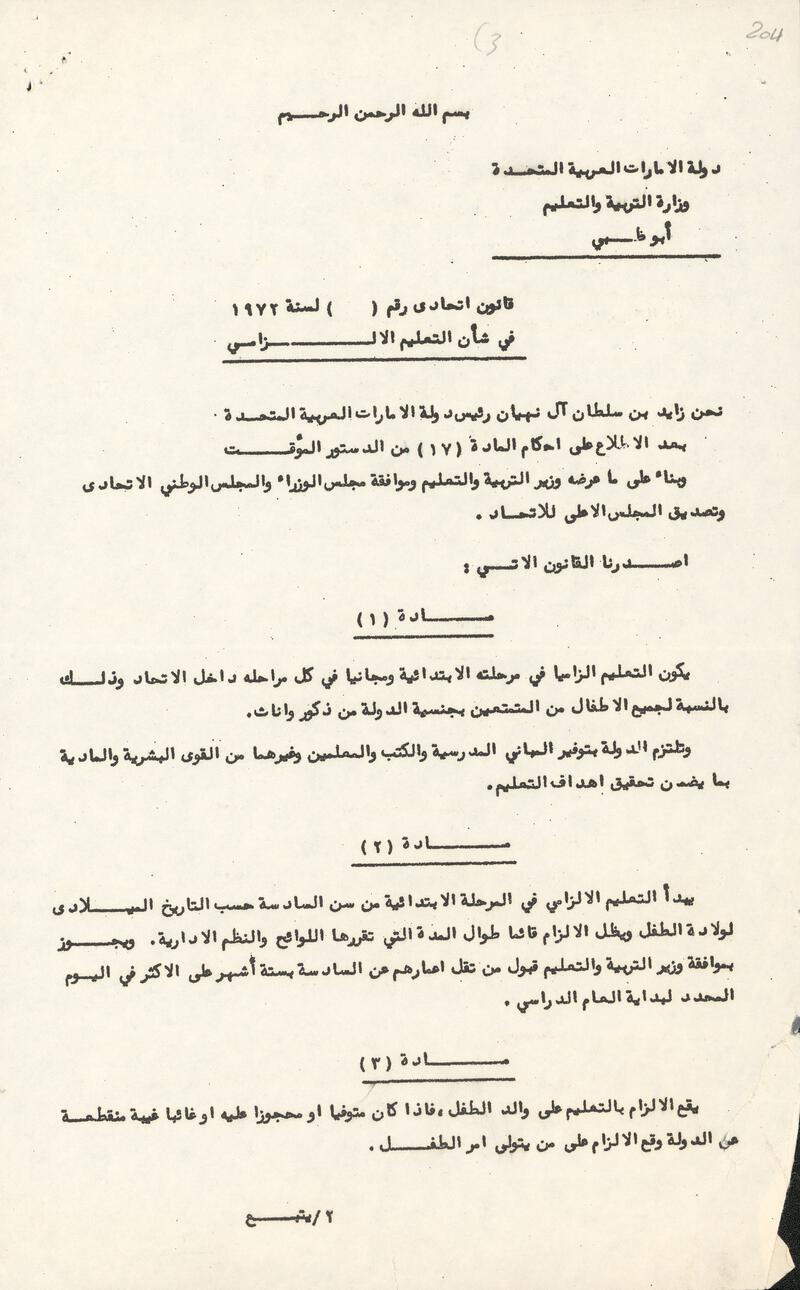
Federal Law of 1972 issued by Sheikh Zayed Bin Sultan Al Nahyan, UAE President, regarding compulsory education, 1972. © UAE National Library and Archives
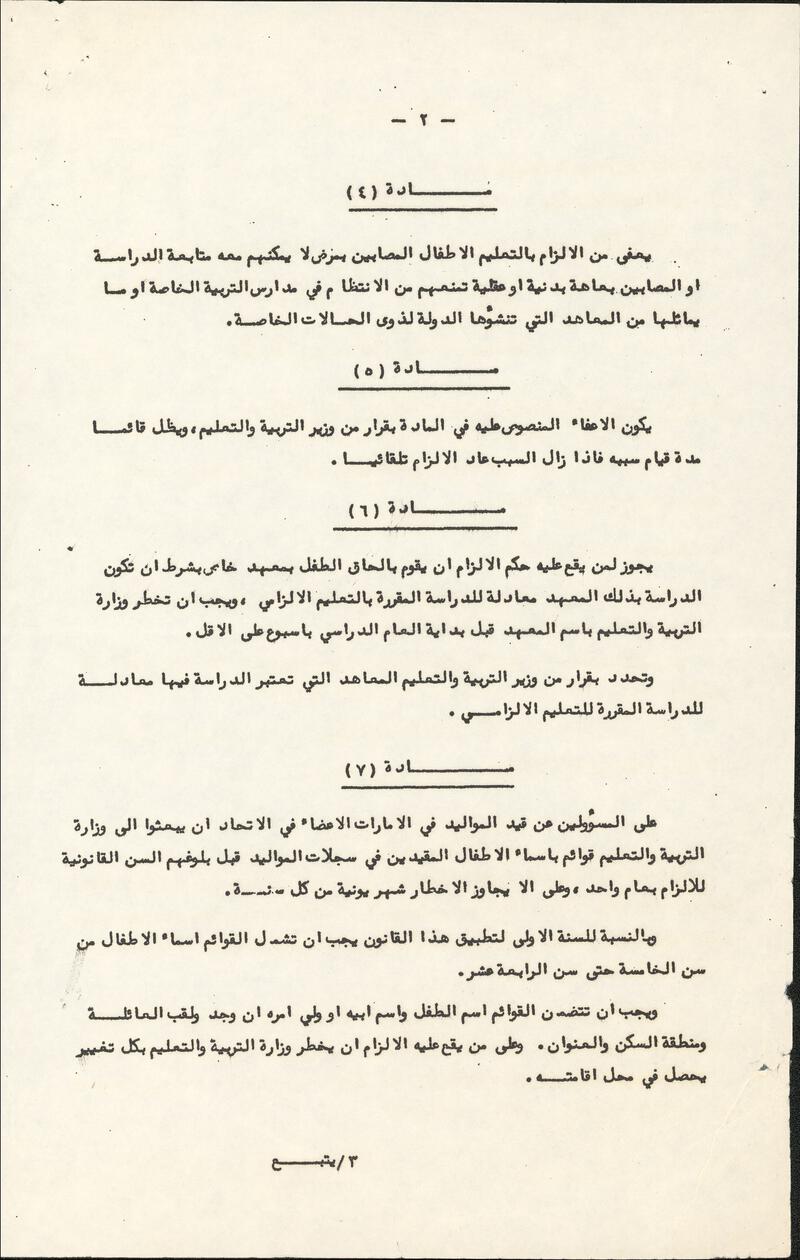
Federal Law of 1972 issued by Sheikh Zayed Bin Sultan Al Nahyan, UAE President, regarding compulsory education, 1972. © UAE National Library and Archives

Federal Law of 1972 issued by Sheikh Zayed Bin Sultan Al Nahyan, UAE President, regarding compulsory education, 1972. © UAE National Library and Archives
Sheikh Zayed Bin Sultan Al Nahyan during his visit to a school in the emirate of Ajman accompanied by Sheikh Mubarak Bin Mohammad Al Nahyan, 12 April 1972. © UAE National Library and Archives
A student writing on a blackboard during an English class, 17 April 1972. © UAE National Library and Archives

Invitation card from the Minister of Education to attend the Sports Festival organized by the Ministry on the Government pitch, under the sponsorship of the UAE President, 24 April 1972. © UAE National Library and Archives

Letter from the British Consul General in Dubai to the Political Agent in Abu Dhabi regarding British teachers in UAE schools, 15 May 1972. © Images reproduced by permission of The National Archives, London, England
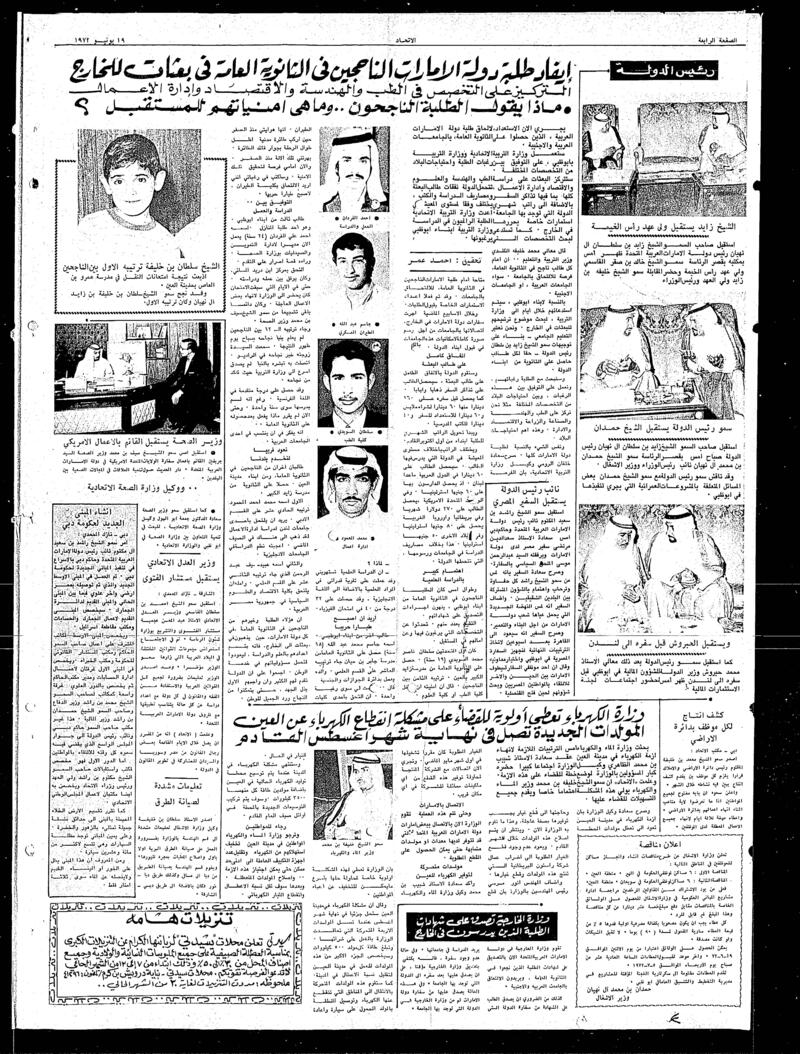
Newspaper article on sending successful UAE high school graduates on scholarships to foreign countries, 19 June 1972. © Al Ittihad Newspaper

Newspaper article on the Council of Ministers approving the establishment of a Higher Committee for literacy campaigns in Abu Dhabi, 13 July 1972. © Al Ittihad Newspaper

Newspaper article on the Ministry of Education finalizing its comprehensive scholarships programs, 13 July 1972. © Al Ittihad Newspaper
Boys’ classrooms, 27 September 1972. © UAE National Library and Archives

Newspaper article on academic delegations and grants in Arab and Foreign universities disbursed by the Government of Abu Dhabi, 12 October 1972. © Al Ittihad Newspaper
Students in an Islamic education class in a school in Abu Dhabi, 13 October 1972. © UAE National Library and Archives
Students in a biology class in a school in Abu Dhabi, 15 October 1972. © UAE National Library and Archives

Extract from the address by Sheikh Zayed Bin Sultan Al Nahyan, President of the UAE, at the opening of the second session of the National Federal Consultative Assembly, 25 November 1972. © UAE National Library and Archives

Extract from the address by Sheikh Zayed Bin Sultan Al Nahyan, President of the UAE, at the opening of the second session of the National Federal Consultative Assembly, 25 November 1972. © UAE National Library and Archives

Newspaper article on the Minister of Education’s announcement at the Scout Camp inauguration ceremony, in the presence of UAE President: 95 schools already established, and 23 new schools to be set up, 4 March 1973. © Al Ittihad Newspaper
Sheikh Zayed Bin Sultan Al Nahyan during his inspection tour of Al Khansa Primary School in Abu Dhabi, 24 April 1973. © Al Ittihad Newspaper
Sheikh Zayed Bin Sultan Al Nahyan, during his inspection tour of Al Khansa Primary School in Abu Dhabi, 24 April 1973. © Al Ittihad Newspaper
Sheikh Zayed Bin Sultan Al Nahyan during his inspection tour of Al Yarmouk Primary School in Abu Dhabi, 24 April 1973. © WAM
Sheikh Zayed Bin Sultan Al Nahyan during his inspection tour of Al Yarmouk Primary School in Abu Dhabi, 24 April 1973. © WAM
Sheikh Zayed Bin Sultan Al Nahyan during his tour of the girls' school exhibition at Khadija Al Kubra Primary School as part of the second public exhibition held by the Ministry of Education in Abu Dhabi on Education Day, 24 April 1973. © Al Ittihad Newspaper
Sheikh Zayed Bin Sultan Al Nahyan during his tour of the girls' school exhibition at Khadija Al Kubra Primary School as part of the second public exhibition held by the Ministry of Education in Abu Dhabi on Education Day, 24 April 1973. © Al Ittihad Newspaper

Newspaper article on the importance of introducing the federation ideology into school curricula, 7 June 1973. © Al Ittihad Newspaper
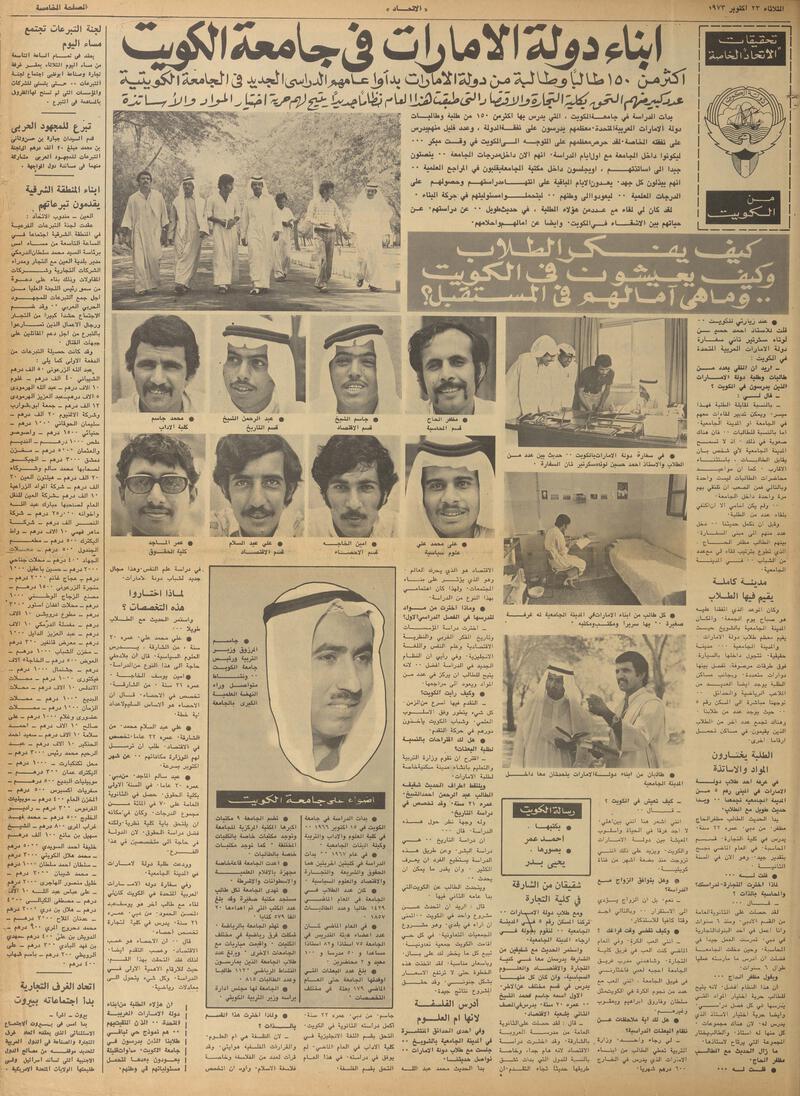
Newspaper article on Emirati students attending Kuwait University, 23 October 1973. © Al Ittihad Newspaper
A student at Zubaida Primary School, 1974. © WAM
Sheikh Zayed Bin Sultan Al Nahyan during a tour of the students' exhibition as part of the 1st Education Day celebrations accompanied by Lebanese Prime Minister, Taqi Al Din Al Solh, and Abdulla Omran Taryam, 25 May 1974. © UAE National Library and Archives
Sheikh Zayed Bin Sultan Al Nahyan handing over academic certificates and prizes to distinguished students on Education Day at Umm Ammar High School in Abu Dhabi, 25 May 1974. © Al Ittihad Newspaper

Newspaper article regarding Sheikh Zayed Bin Sultan Al Nahyan offering UAE students monthly allowances, 17 September 1974. © Al Ittihad Newspaper
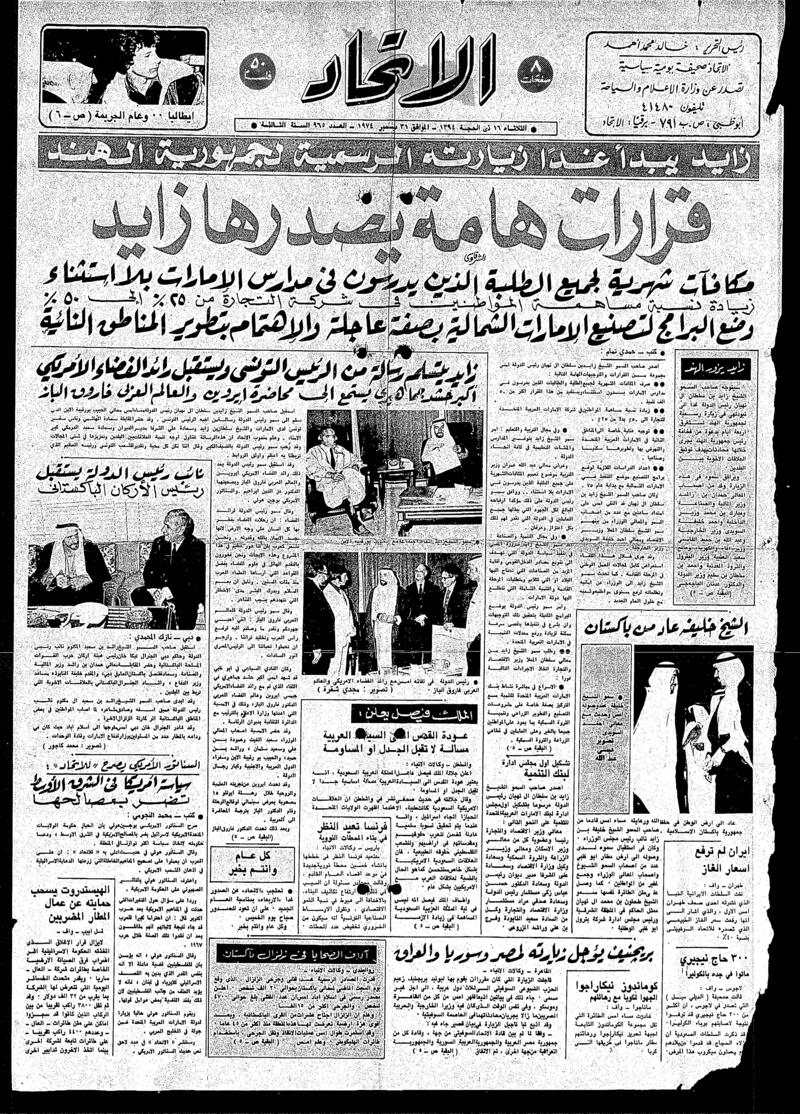
Newspaper article on a key decision taken by Sheikh Zayed Bin Sultan Al Nahyan to offer monthly allowances to all students in the UAE with no exception, 31 September 1974. © Al Ittihad Newspaper
Examination day at Sultan Bin Zayed School in Al Ain, 17 May 1975. Abdulla Al Balushi © UAE National Library and Archives
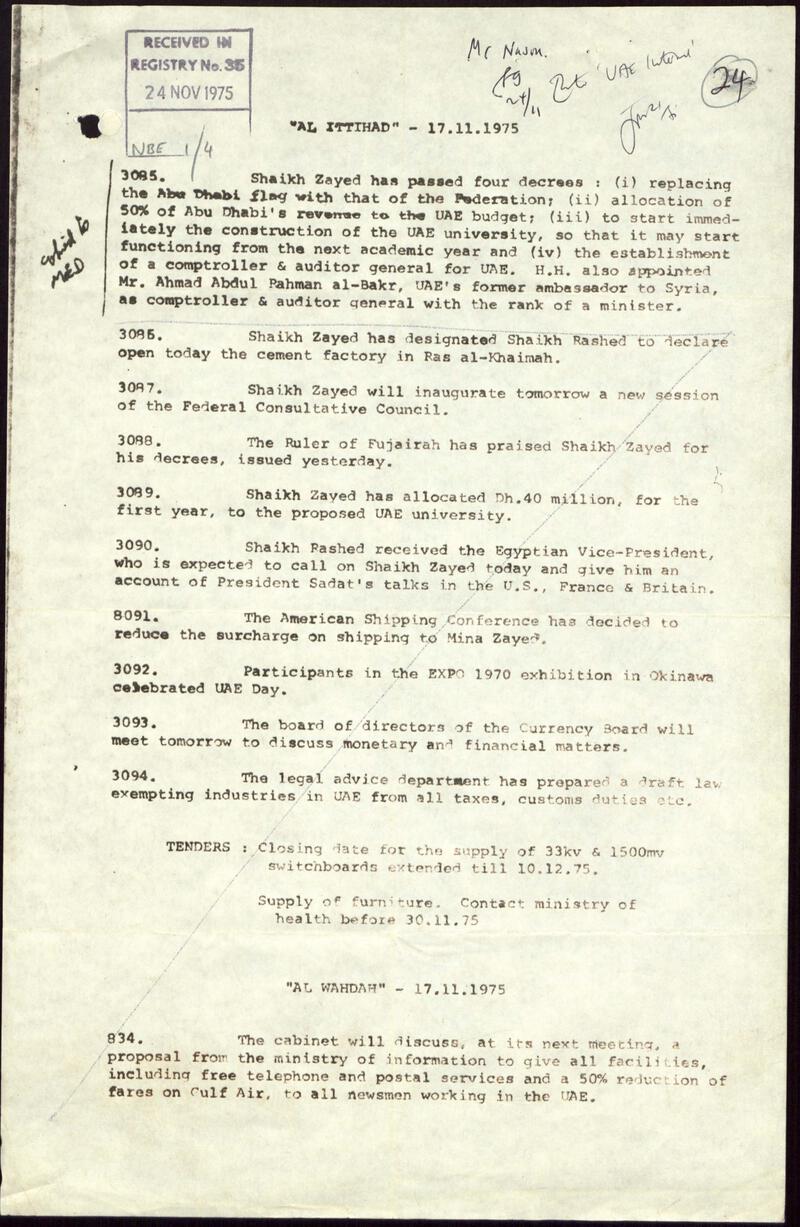
Article from “Al Ittihad” newspaper on the developments that took place in the United Arab Emirates under the leadership of Sheikh Zayed Bin Sultan Al Nahyan, 17 November 1975. © Images reproduced by permission of The National Archives, London, England
Al Qattara Primary School for Girls, Al Ain, 1975. Abdulla Al Balushi © UAE National Library and Archives
Students standing in line before the start of the morning classes in a boys school in Al Ain, 1975. Abdulla Al Balushi © UAE National Library and Archives
Students standing in line before the start of the morning classes in a boys school in Al Ain, 1975. Abdulla Al Balushi © UAE National Library and Archives
Students standing in line before the start of the morning classes in a boys school in Al Ain, 1975. Abdulla Al Balushi © UAE National Library and Archives

Newspaper article on the allocation of AED 35 million in the 1976 budget for the establishment of the UAE University, 13 January 1976. © Al Ittihad Newspaper
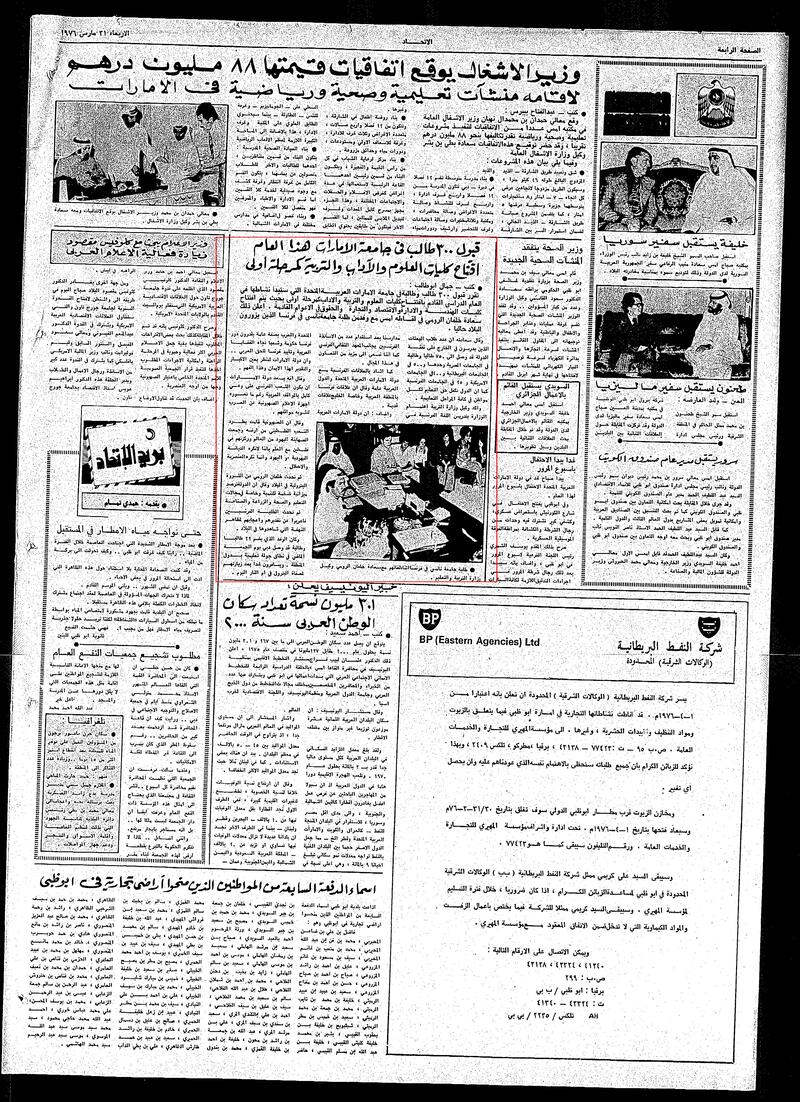
Newspaper article on the acceptance of 300 students in the UAE University for this academic year, and the inauguration of the science, literature and education departments as part of the first phase, 31 March 1976. © Al Ittihad Newspaper
Al Muwaiji Kindergarten and School in Al Ain, 2 October 1976. Abdulla Al Balushi © UAE National Library and Archives
Al Muwaiji Kindergarten and School in Al Ain, 2 October 1976. Abdulla Al Balushi © UAE National Library and Archives
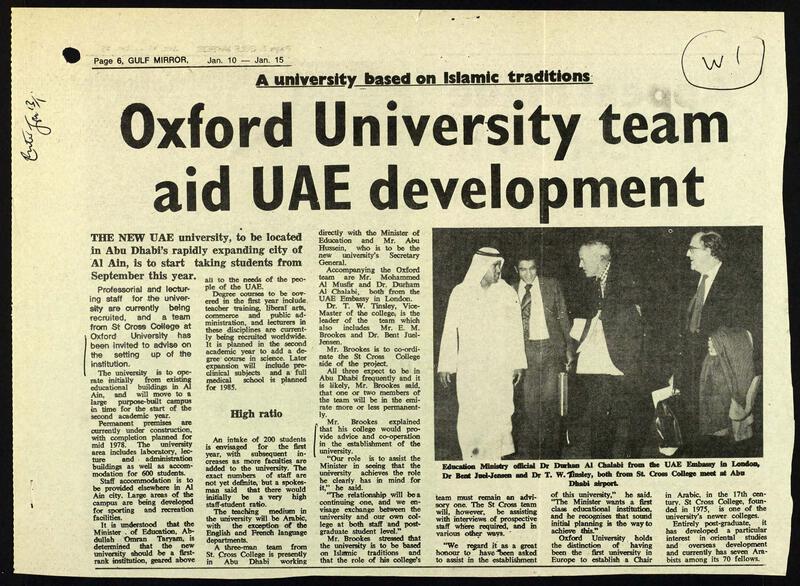
Press cutting from Gulf Mirror, “Oxford University team aid UAE development”, 10-15 January 1977. © Images reproduced by permission of The National Archives, London, England

Informal meeting of the UK/UAE Joint Committee to discuss educational topics at the UAE Embassy, London, 11 August 1977. © Images reproduced by permission of The National Archives, London, England
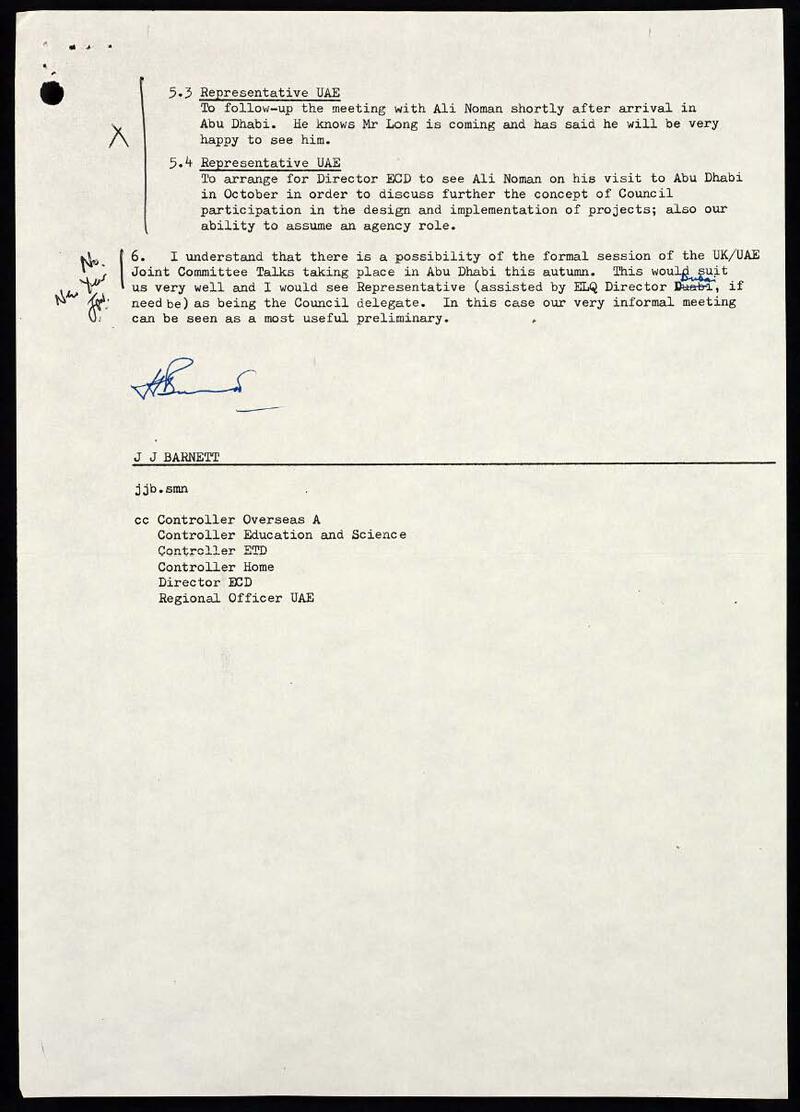
Informal meeting of the UK/UAE Joint Committee to discuss educational topics at the UAE Embassy, London, 11 August 1977. © Images reproduced by permission of The National Archives, London, England

Newspaper article on Sheikh Zayed Bin Sultan Al Nahyan meeting with UAE University students ahead of his inauguration of the University, 9 November 1977. © Al Ittihad Newspaper

Newspaper article on Sheikh Zayed Bin Sultan Al Nahyan, UAE President, confirming that money is to be put in the service of education, and that the best investment of money is building generations of educated citizens, 11 November 1977. © Al Ittihad Newspaper

Newspaper article on the UAE President officially inaugurating the UAE University during an Arab and international ceremony, 11 November 1977. © Al Ittihad Newspaper
Sheikh Zayed Bin Sultan Al Nahyan during an inspection tour of one of Ghayathi schools, 4 May 1978. © WAM
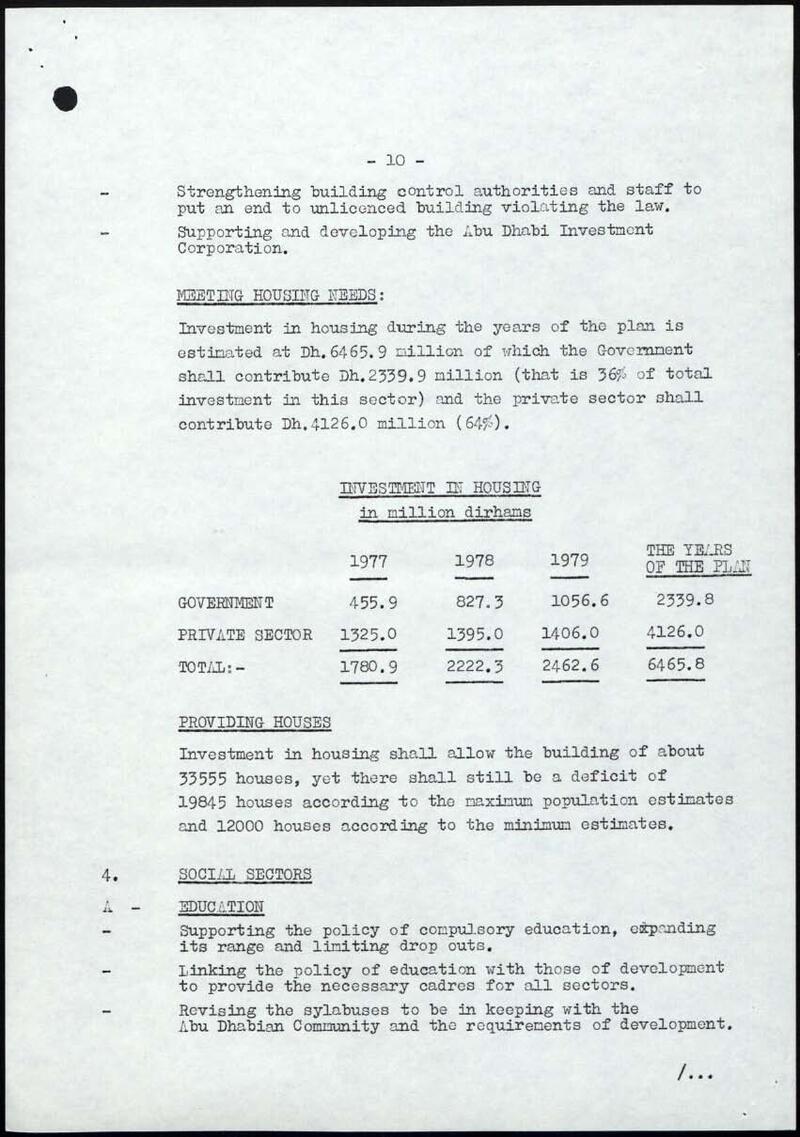
Extract from the draft development plan for the Emirate of Abu Dhabi, 1977-1979. © Images reproduced by permission of The National Archives, London, England
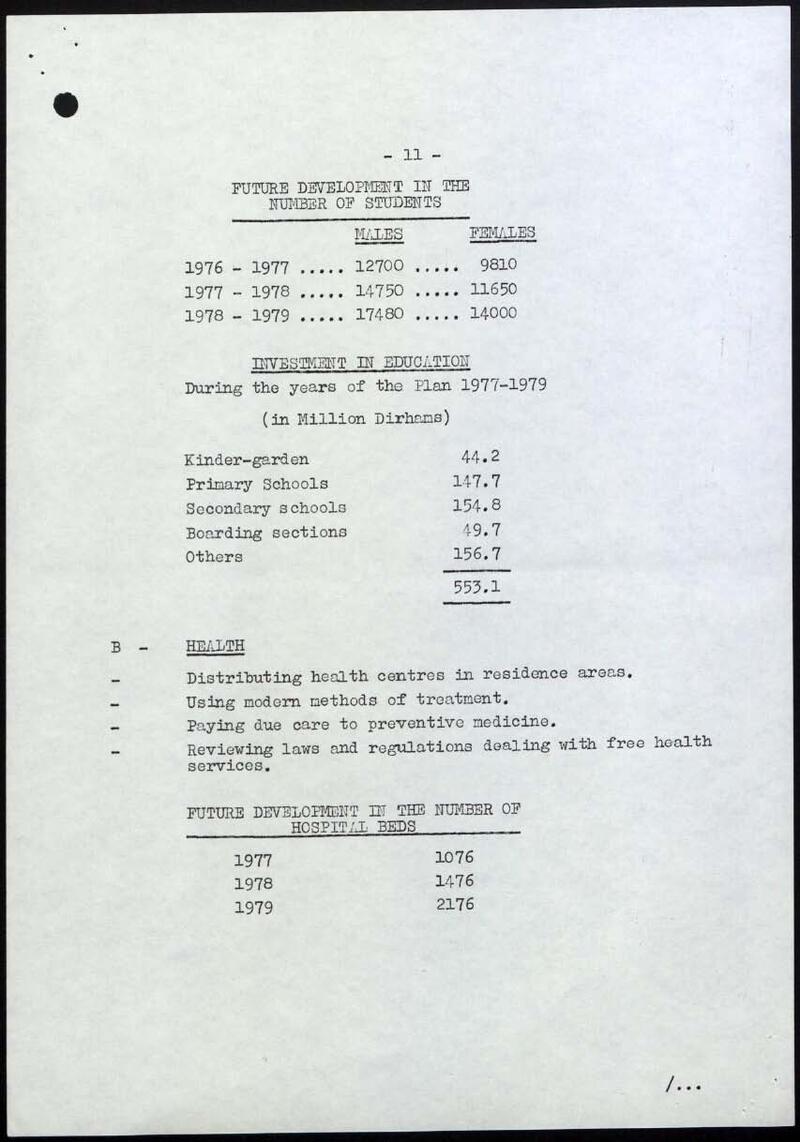
Extract from the draft development plan for the Emirate of Abu Dhabi, 1977-1979. © Images reproduced by permission of The National Archives, London, England

Newspaper article regarding 68 UAE University students achieving excellence and featuring on the honor’s list on the first academic term, 13 February 1979. © Al Ittihad Newspaper
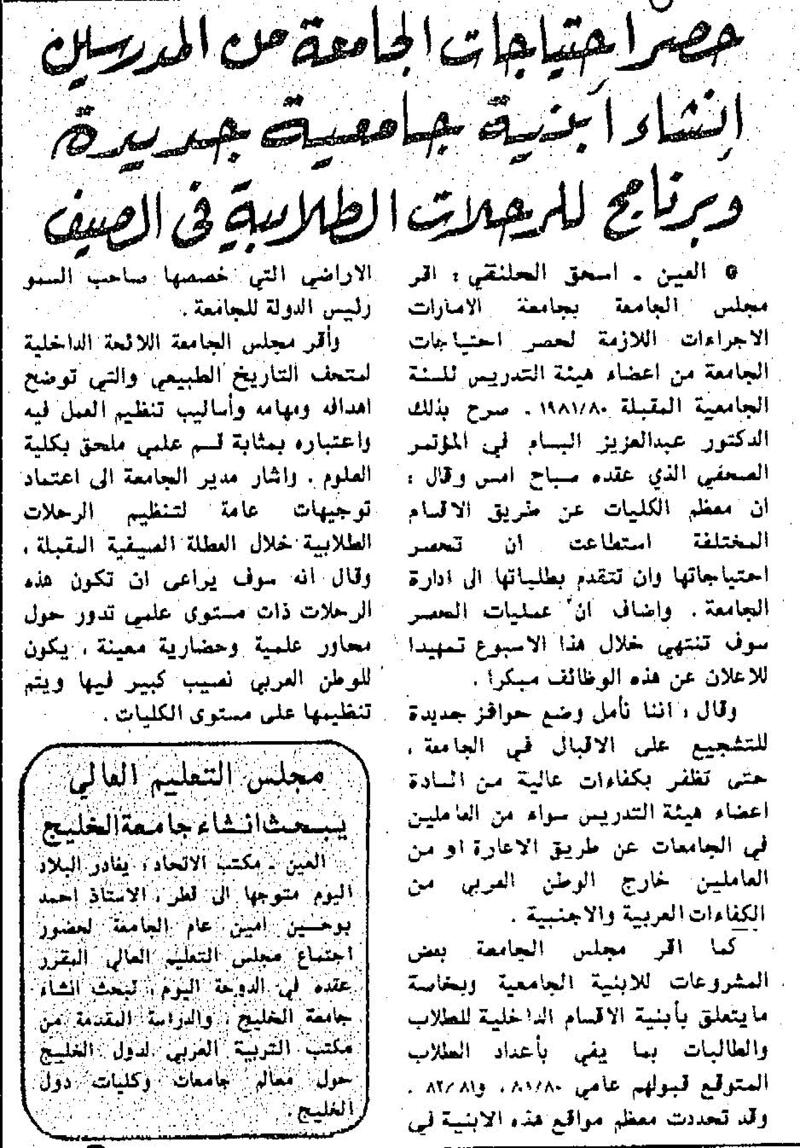
Newspaper article on tallying the UAE University’s requirements for professors, and setting up new facilities and summer field trip programs for students, 13 November 1979. © Al Ittihad Newspaper
Sheikh Zayed Bin Sultan Al Nahyan during an inspection tour of one of the schools in Ghayathi, 18 October 1979. © UAE National Library and Archives
Sheikh Zayed Bin Sultan Al Nahyan during an inspection tour of one of the schools in Ghayathi, 18 October 1979. © UAE National Library and Archives
Sheikh Zayed Bin Sultan Al Nahyan during an inspection tour of one of the schools in Ghayathi, 18 October 1979. © UAE National Library and Archives
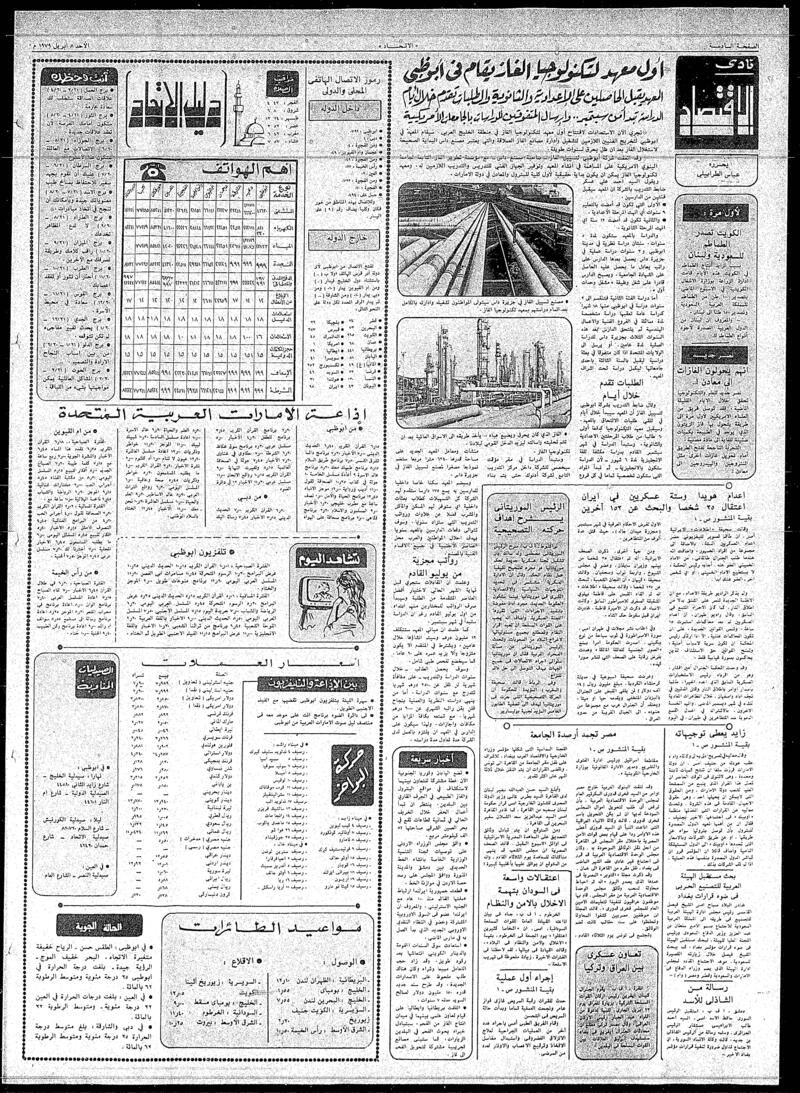
Newspaper article on the first institute specialized in gas technology to be established in Abu Dhabi, 8 April 1979. © Al Ittihad Newspaper
Sheikh Zayed Bin Sultan Al Nahyan on a visit to the Holy Quran Memorization Centre in Liwa, 10 July 1980. © UAE National Library and Archives

Newspaper article on the Ministry of Education praising the increasing success rates among high school students, 17 June 1981. © Al Ittihad Newspaper
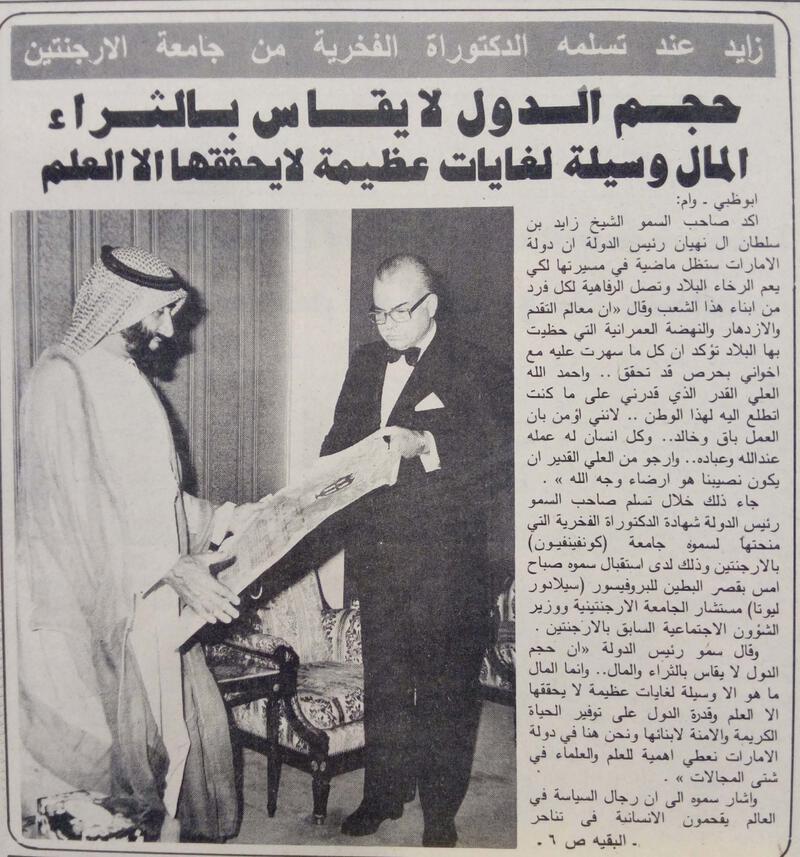
Newspaper article on Sheikh Zayed Bin Sultan Al Nahyan receiving an honorary doctorate from the University of Argentina, 9 November 1981. © Al Ittihad Newspaper
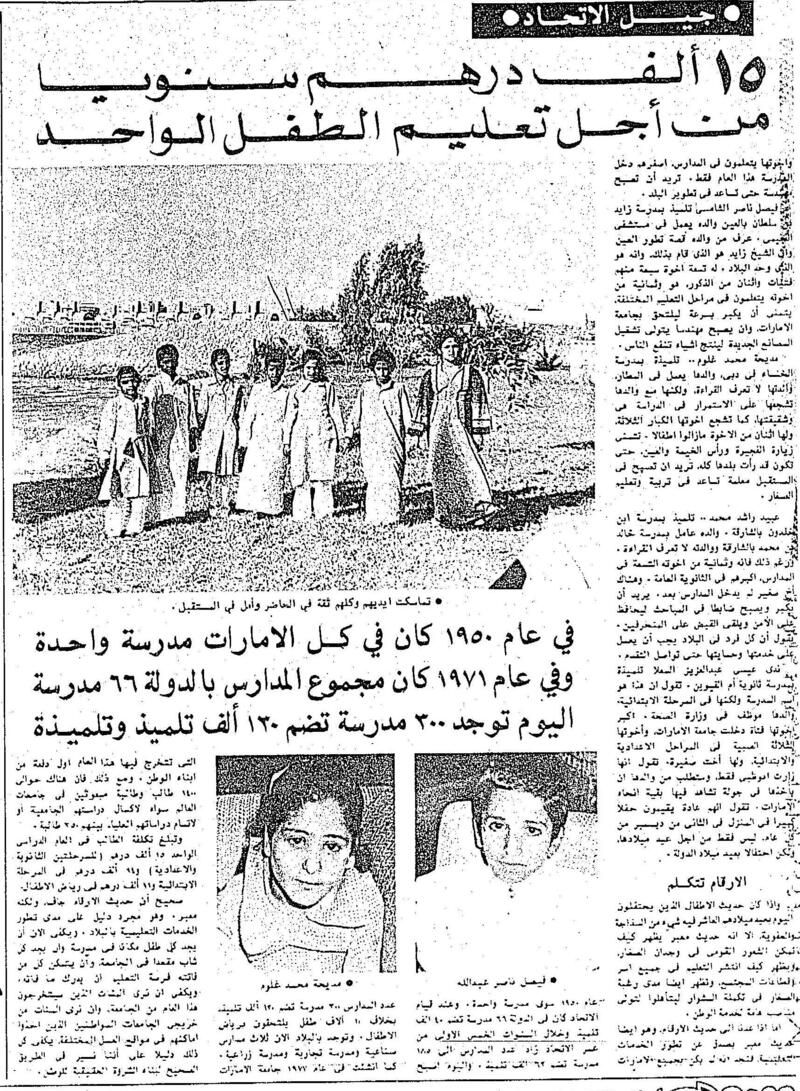
Newspaper article on the cost of education in the UAE reaching up to AED 15,000 per child per annum, 3 December 1981. © Al Ittihad Newspaper

Newspaper article on Sheikh Zayed Bin Sultan Al Nahyan addressing university student: "Arm yourselves with education, as you are the future’s ammunition", 8 December 1981. © Al Ittihad Newspaper

Newspaper article on Sheikh Zayed Bin Sultan Al Nahyan inviting members of the University’s Supreme Council to discuss all issues with honesty and clarity, 28 February 1982. © Al Ittihad Newspaper

Newspaper article on the UAE President and Members of the Supreme Council attending the graduation ceremony of the first batch of students from the UAE University, 1 March 1982. © Al Ittihad Newspaper

Newspaper article on the UAE President and Members of the Supreme Council attending the graduation ceremony of the first batch of students from the UAE University, 1 March 1982. © Al Ittihad Newspaper

Newspaper article on the UAE University allocating an 80% quota for Emirati students, 14 June 1982. © Al Ittihad Newspaper
Sheikh Zayed Bin Sultan Al Nahyan receiving UAE students at his residence in Lahore, Pakistan, 24 February 1983. © UAE National Library and Archives
Sheikh Zayed Bin Sultan Al Nahyan, UAE President, at the closing ceremony for a school event, 1983. © UAE National Library and Archives
Sheikh Zayed Bin Sultan Al Nahyan, UAE President, touring boys and girls’ schools in Ghayathi, accompanied by Sheikh Mohammad Bin Zayed Al Nahyan, 1983. Source: UAE National Library and Archives
The graduation ceremony of the third batch of the UAE University students in Al Ain, 10 April 1984. © UAE National Library and Archives

Newspaper article on the graduation of the third batch of students from the UAE University, in the presence of the UAE President, 21 April 1985. © Al Ittihad Newspaper

Newspaper article on UAE President and Members of the Supreme Council attending the graduation of the 4th batch of students from the UAE University, 21 April 1985. © Al Ittihad Newspaper

Newspaper article on UAE President and Members of the Supreme Council attending the graduation of the 4th batch of students from the UAE University, 21 April 1985. © Al Ittihad Newspaper
Sheikh Zayed Bin Sultan Al Nahyan inviting students to have good ethics and an impeccable behavior, while stressing on the importance of education, 1987. © UAE National Library and Archives

Newspaper article on statistics highlighting that 215 Emirati doctors have graduated between 1972 and 1991, 10 November 1991. © Al Ittihad Newspaper

Newspaper article on the Ministry of Education’s statistics showing 23,000 individuals benefitting from the literacy and senior education centers, 5 December 1991. © Al Ittihad Newspaper
Sheikh Zayed Bin Sultan Al Nahyan meeting with cadets in London, encouraging students to pursue their education, 1998. © UAE National Library and Archives

Newspaper article on Sheikh Mohammad Bin Zayed Al Nahyan launching the Abu Dhabi Education Council’s strategy, in the presence of Sheikh Mansour Bin Zayed Al Nahyan, 13 November 2005. © Al Ittihad Newspaper
Sheikh Mohammad Bin Rashid Al Maktoum with children and teachers during his visit to Delma Island school at the start of the new academic year, 4 September 2006. © WAM
Sheikh Mohammad Bin Rashid Al Maktoum with children and teachers during his visit to Delma Island school at the start of the new academic year, 4 September 2006. © WAM

Newsaper article on Sheikh Mohammad Bin Rashid Al Maktoum’s decision to accept 1555 students in the colleges for technology, 26 September 2006. © Al Ittihad Newspaper
Sheikh Mohammad Bin Zayed Al Nahyan visiting Dhat Al Salasil Girls School in Al Ain, 14 January 2007. © WAM

Newspaper article on Sheikh Mohammad Bin Zayed Al Nahyan chairing the first Board of Trustees meeting at the Khalifa University of Science and Technology, confirming that universities are at the core of innovation and novelty, 17 June 2008. © Al Ittihad Newspaper
Sheikh Mohammad Bin Rashid Al Maktoum, with schoolchildren during his nationwide tour of the country, 2008. © WAM
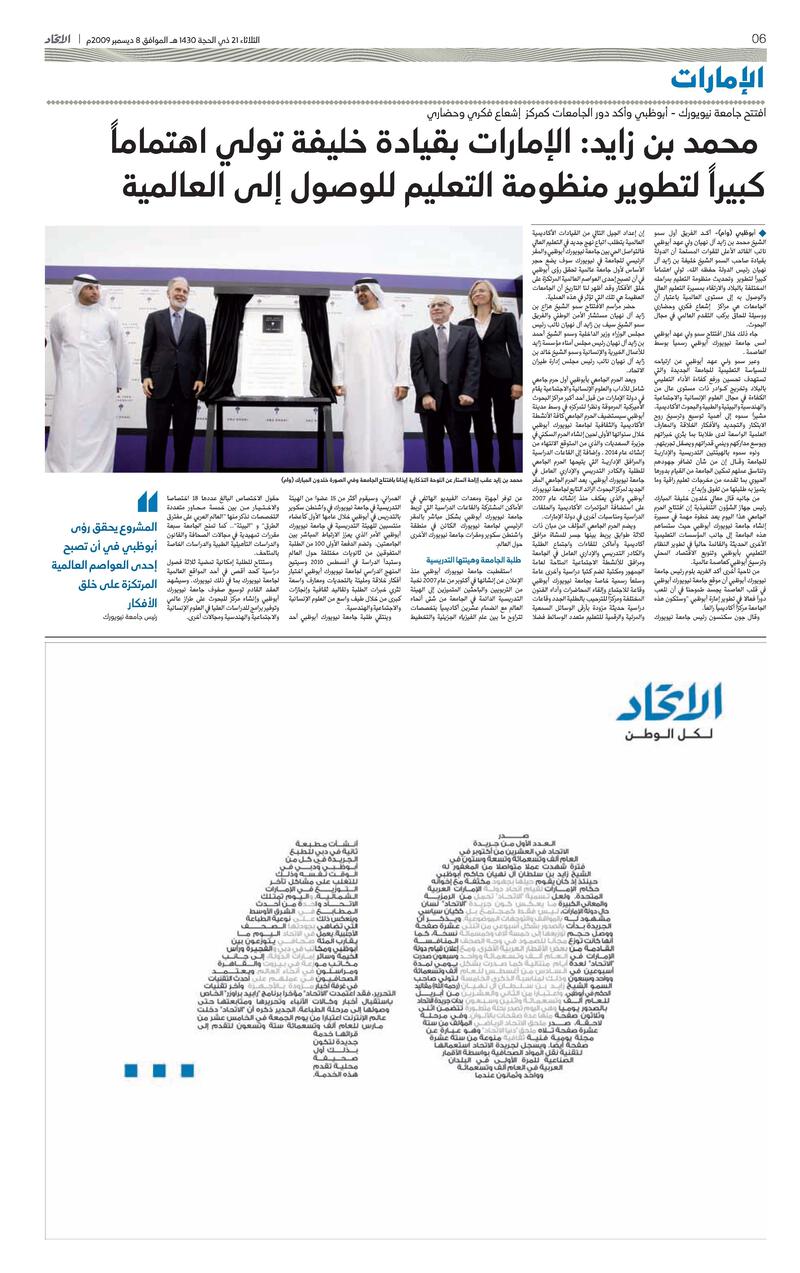
Newspaper article on the inauguration of New York University – Abu Dhabi, and the undeniable role of universities in the enlightenment of minds and civilizations, 8 December 2009. © Al Ittihad Newspaper
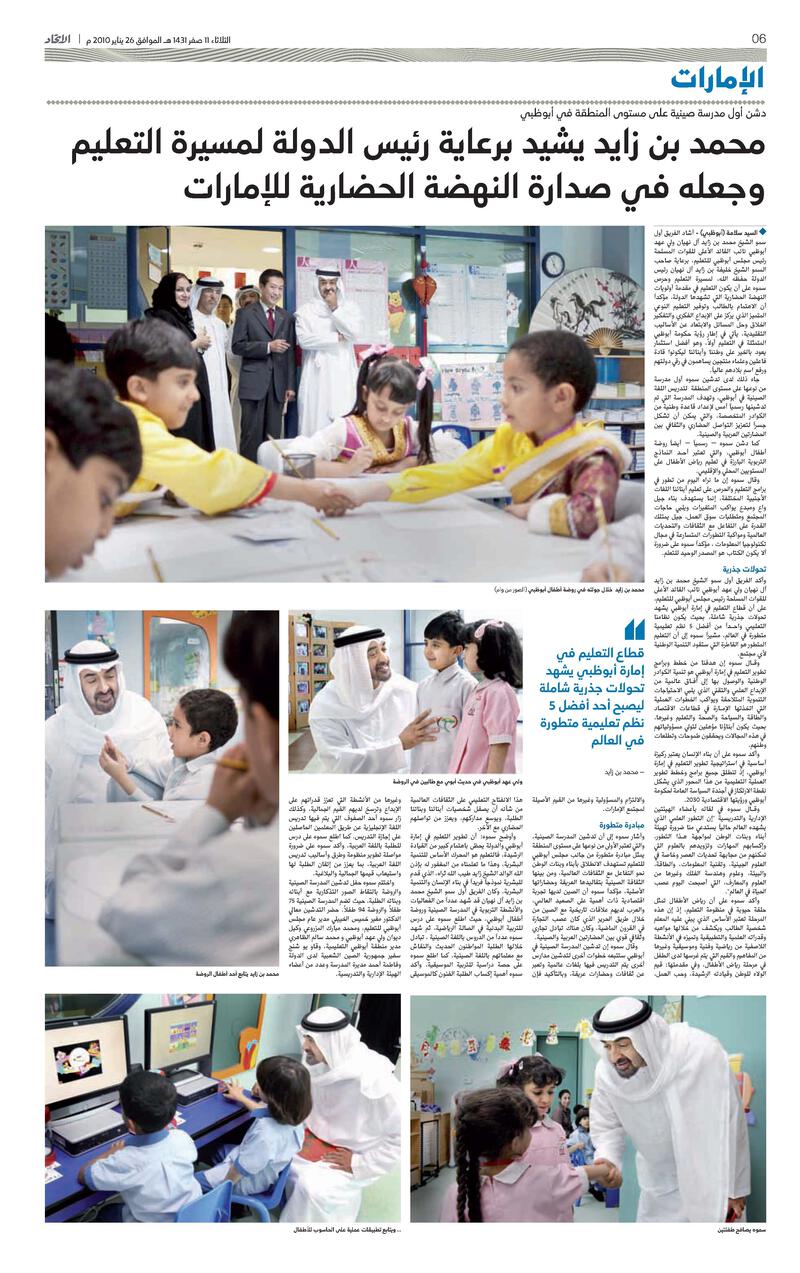
Newspaper article on Sheikh Mohammad Bin Zayed Al Nahyan inaugurating the first Chinese school in the region in Abu Dhabi, and his praise of UAE President’s patronage of education, 26 January 2010. © Al Ittihad Newspaper
Sheikh Mohammad Bin Zayed Al Nahyan inspecting Zayed University programs, 6 March 2011. © WAM
Sheikh Mohammad Bin Zayed Al Nahyan, during his visit to a school, accompanied by Sheikh Hazza Bin Zayed Al Nahyan and Dr. Mugheer Khamis Al Khaili, 25 October 2011. © WAM
Sheikh Mohammad Bin Rashid Al Maktoum during his visit to Al Ahlia Charity Schools responding to the wishes of the student Mira Ali Murad, 17 February 2013. © WAM
Sheikh Mohammad Bin Zayed Al Nahyan during his visit to Mubarak Bin Mohammad School in the presence of Sheikh Nahyan Bin Mubarak Al Nahyan, 19 January 2017. © WAM



